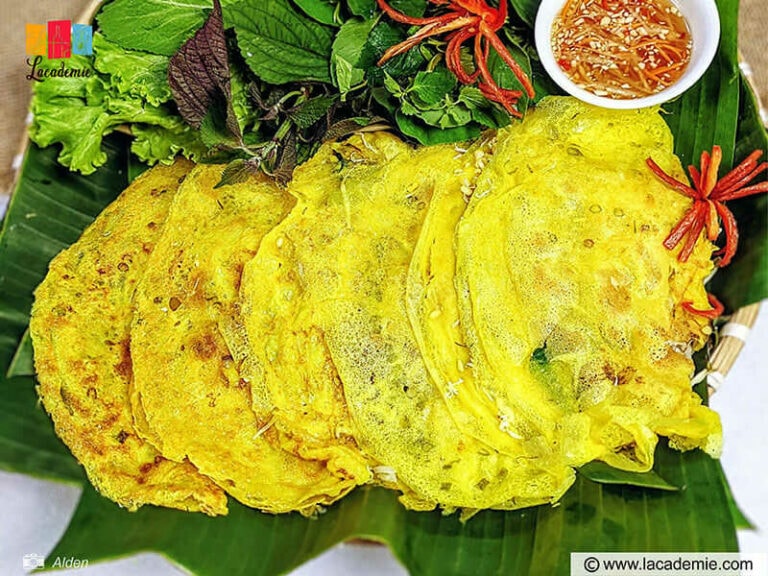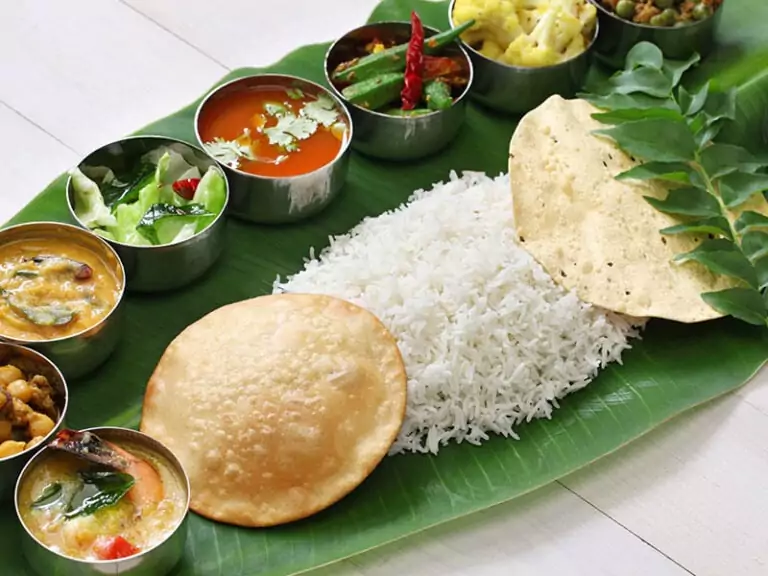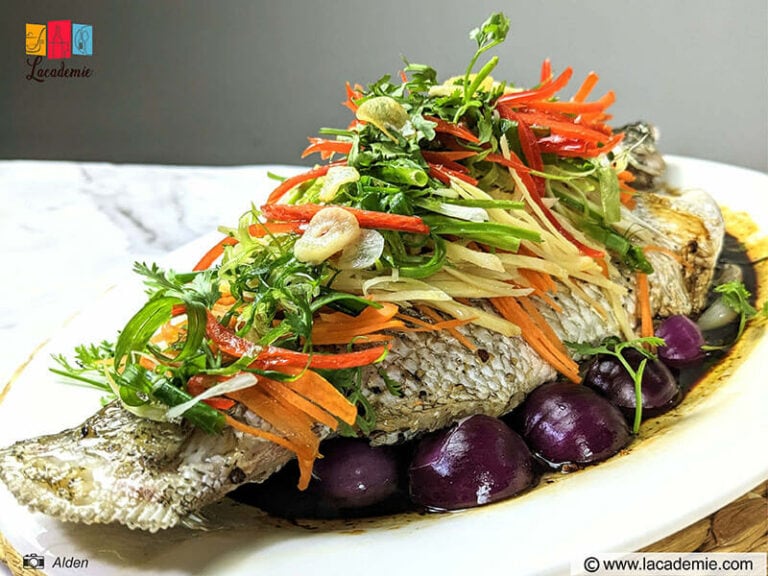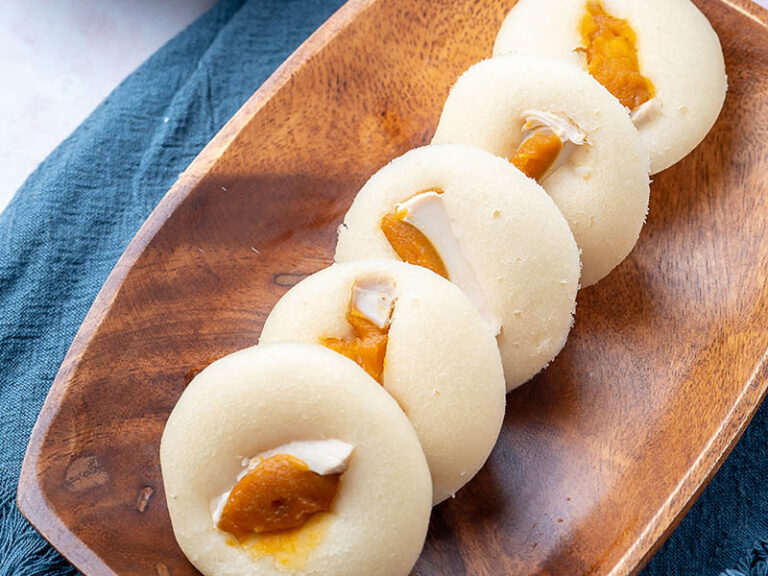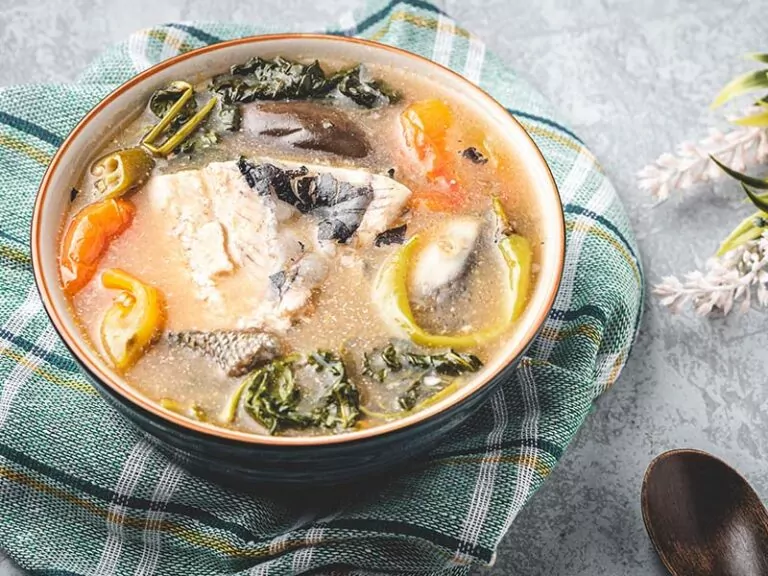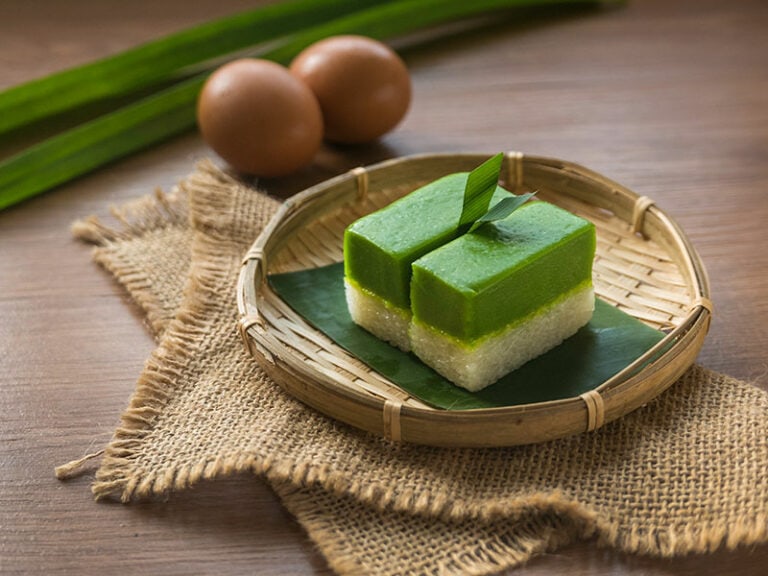Middle Eastern foods serve as the guiding star in this article, steering you on a flavorful culinary journey. Look forward to an explosion of aromatic spices, exotic ingredients, and delicious dishes, reminiscent of the lively streets of the Middle East.
You’ll discover the rich history behind Middle Eastern cuisine and unlock the secrets to creating tantalizing flavors in your kitchen. Join me to delve into the irresistible world of Middle Eastern Foods and unlock a world of gastronomic delights!
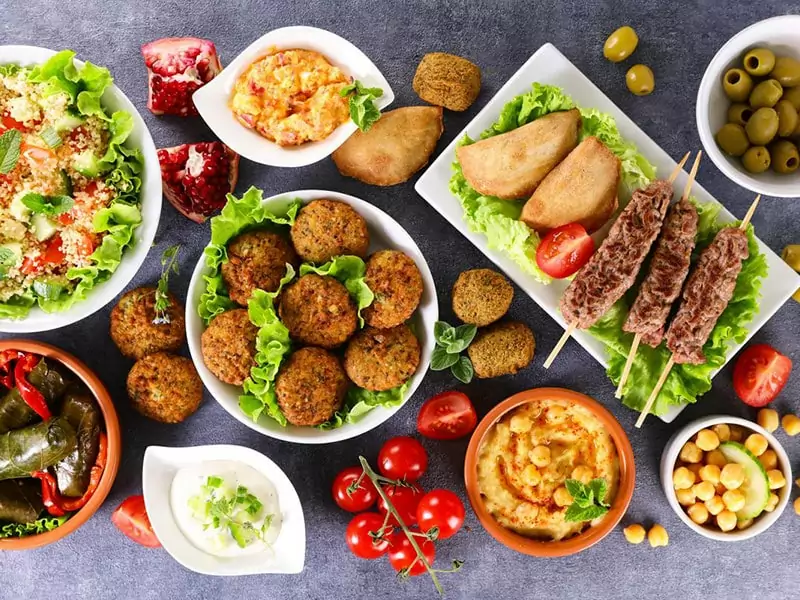
Brief Overview Of Middle Eastern Cuisine
Middle Eastern cuisine is a diverse and rich culinary tradition spanning several countries and centuries. It includes the foods of many countries, such as Lebanon, Egypt, Iran, Turkey, Saudi Arabia, Iraq, and Israel, to name just a few.
Middle Eastern food draws upon the abundant agricultural resources of the region and has been influenced by various cultural interactions over the centuries, including trade routes, invasions, and migrations. Its influence can be seen in other cuisines, from Europe to South Asia and even the Americas.
At its heart, Middle Eastern cuisine is a celebration of simple, fresh ingredients combined in dishes that prioritize flavor, nutrition, and communal dining. The region’s abundant sunshine and fertile soil produce various fruits, vegetables, and grains that form the base of many meals.
In addition, it’s notable for its love of herbs, spices, and olive oil, all of which feature prominently in its cuisine.
Key Characteristics Of Middle Eastern Foods
Core Ingredients In Middle Eastern Cuisine
Middle Eastern cuisine is built on grains like wheat and rice, and legumes including chickpeas, lentils, and fava beans. Various Middle Eastern spices and herbs like cumin, coriander, turmeric, parsley, and mint boost flavors, and olive oil is a common addition.
The main proteins are lamb, chicken, beef, and various fish. Essential middle eastern fruits and vegetables comprise dates, pomegranates, tomatoes, cucumbers, and eggplants.
Middle Eastern Drinks
In the Middle East, drinks are as diverse and flavorful as the food. Tea is central to Middle Eastern hospitality, often spiced with cardamom or mint. Arabic coffee, which is usually lightly roasted and flavored with cardamom, is another popular choice.
In warmer months, refreshing Middle Eastern drinks like mint lemonade and tamarind juice are common. Non-alcoholic fermented drinks like ayran and doogh, made from yogurt, are also traditional favorites.
Middle Eastern Street Foods
Street food plays a significant role in Middle Eastern cuisine. Popular choices include shawarma, a sandwich filled with thinly sliced marinated meat, and falafel, deep-fried balls of ground chickpeas.
Other must-try Middle Eastern street foods include sfiha (meat pies), manakeesh (flatbread topped with za’atar or cheese), and stuffed breads like gozleme. These foods are often enjoyed on-the-go, providing a quick, affordable, and flavorful meal.
Role Of Food In Traditional Gatherings And Celebrations
Food is an integral part of traditional gatherings and celebrations in the Middle East. Meals are often served family-style, with multiple dishes shared among the group, promoting a sense of togetherness.
Special occasions call for specific dishes; for example, during Eid al-Fitr, the feast marking the end of Ramadan, sweet dishes like baklava and maamoul (date-filled cookies) are often prepared.
Food And Hospitality In Middle Eastern Culture
Middle Eastern culture greatly emphasizes hospitality, and food plays a central role in this tradition.
It’s common to offer food and drink to guests as soon as they arrive. Sharing a meal is seen as an expression of friendship and respect. The act of breaking bread together is symbolic of peace and fellowship.
The Role Of Food In Religious Observances
In the Middle East, where the predominant religions are Islam, Christianity, and Judaism, food plays a significant role in religious observances.
During Ramadan, Muslims fast from sunrise to sunset, breaking their fast with the evening meal known as Iftar, often starting with dates and water or yogurt-based drinks, followed by a main meal.
In Jewish tradition, foods like matzah (unleavened bread) and charoset (a sweet paste made of fruits and nuts) are consumed during Passover. In Christian communities, Easter may be celebrated with maamoul, which are sweet pastries filled with dates or nuts.
These traditions underline the profound connection between food, faith, and community in the Middle East.
Turkey
1. Ayran (Turkish Yogurt Drink)
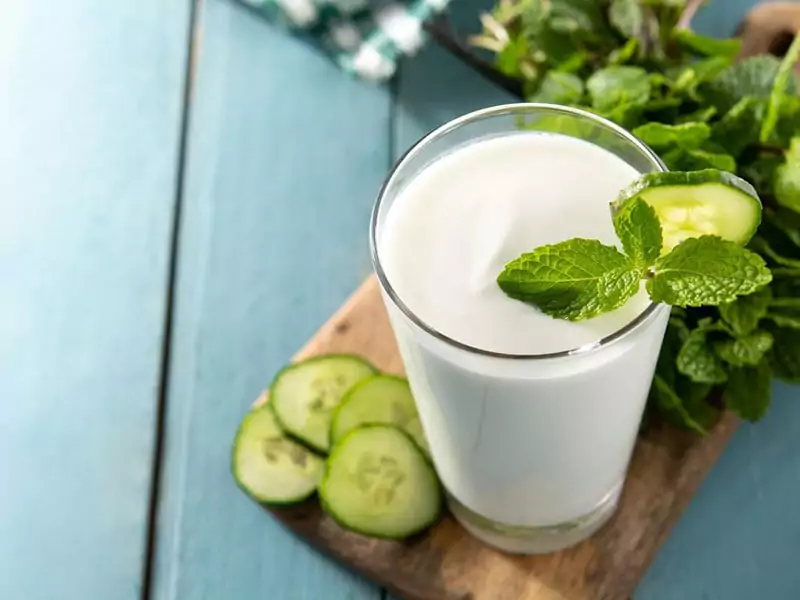
Ayran, or as it’s known in various regions, Doogh, Daw, Xynogala, or Tan, is a cold, diluted yogurt-based beverage. With a base of yogurt, salt, and water, this thirst-quenching drink hails from Asia, particularly North Asia, Central Asia, and Western Asia. It also originates from Southeastern Europe and Eastern Europe.
This fascinating Turkish beverage has many tweaks; some might sprinkle in herbs like mint, while others might carbonate it, creating a slightly effervescent experience. Also, Ayran pairs wonderfully with hearty foods like kebabs, rice, spicy dishes, and grilled meats.
Alternatively, adding veggies and greens turns it into a chilled appetizer, providing a delectable cool-down before the main course. Adding black pepper and lime juice imparts a different zest, while some prefer to add cucumber for an added crunch.
2. Börek (Turkish Filled Pastry)
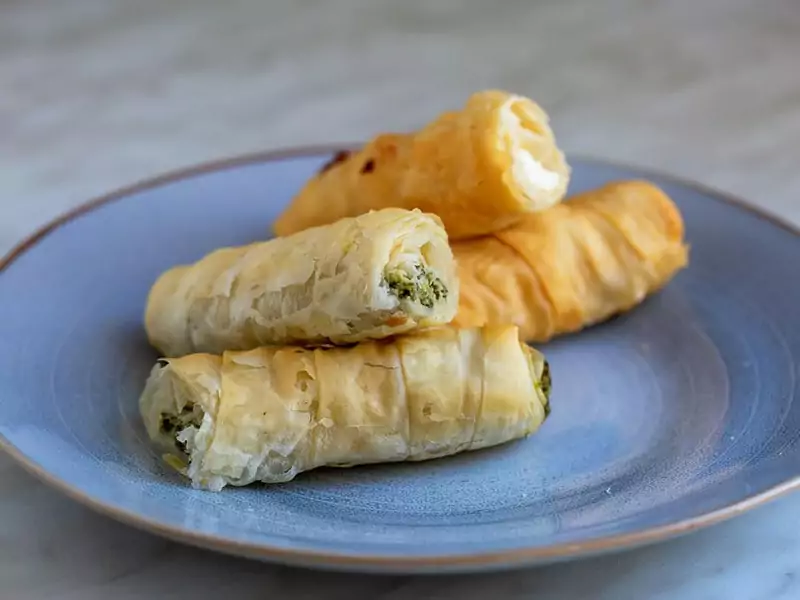
This family of pastries or pies, Börek, is a true gastronomic gem of Turkey, born in Anatolia. It is also available in the Middle East, Central Asia, and the Balkans. The defining characteristic of Börek is its thin, flaky dough, most often filo, which encases fillings like cheese, meat, potatoes, or spinach.
I simply can’t get enough of the extra crunch of the nigella seeds on its golden crust. While baking is the traditional method of preparation, some tantalizing versions are fried. In addition, Börek is a traditional Shabbat breakfast meal on Saturday mornings for Sephardic Jews.
The pastry fits perfectly into any time of day, a breakfast complement to coffee, a snack with afternoon tea, or a cooling yogurt beverage accompaniment. Whether served hot or cold, Börek is simply a must-try, especially for guests.
3. Ashure (Noah’s Pudding)

Known as Ashure or Trigo Koço, this sweet pudding of Eastern Mediterranean origin has garnered popularity across the Balkans, Turkey, and Armenia. The dish is a sophisticated combination of various legumes, nuts, and fruits, both fresh and dried.
Usually, locals employ grains ranging from chickpeas to wheat, beans, barley, and rice. As for the fruits, they include figs, raisins, apricots, apples, and currants, while nuts such as pistachios, hazelnuts, almonds, and pine nuts are often used.
Interestingly, Ashure does not stick to a specific recipe. Instead, the pudding embraces a multitude of ingredients of at least seven to ten components.
Though traditionally consumed during the colder months due to its high-calorie content and hearty nature, Ashure is also enjoyed throughout the year. The communal significance of this Turkish sweet treat is evident in its preparation, as it is typically made in large quantities and distributed among friends and relatives.
This dish symbolizes abundance and fertility and is believed to represent the soup that Noah’s family prepared using the remaining food on the Ark post the Great Flood.
The dish also appears as a Christmas pudding and New Year’s celebration dish in Armenia. It is also served during Muharram in Turkey and the Balkans. Furthermore, Ashure is prepared by Sephardic Jews for the Jewish holiday of Tu Bishvat.
4. Revani (Turkish Semolina Cake)
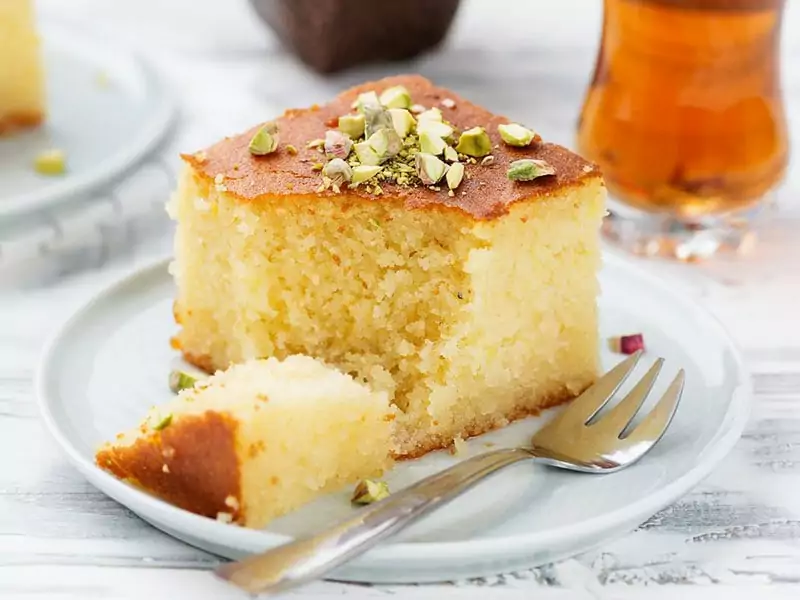
Revani, a sweet semolina cake steeped in syrup invented by a palace chef, originates from Egypt. The dish later spread across many nations of the former Ottoman Empire.
The cake often has sweeteners like rose water, orange flower water, and simple syrup to create its characteristic sweetness. Distinctively, Revani contains eggs and flour, setting it apart from Basbousa, its delicious cousin.
In addition, the cake features shredded coconut and pistachios, adding a beautiful contrast and a tasty crunch. Inclusions like yogurt give Revani a moist, rich texture. For that, the treat is often served to guests. Whipped cream or a scoop of ice cream make excellent companions to elevate its flavors.
5. Malabi (Israeli Rose Water Milk Pudding)
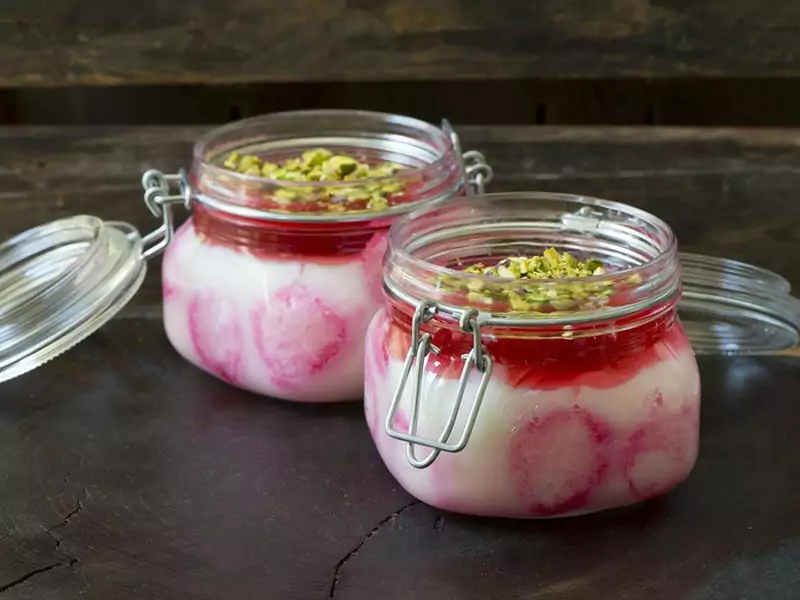
The legend of Malabi is as captivating as its taste. When a Persian cook in the late seventh century, serving an Arab general, introduced it into Arab cuisine. In recognition, the general named the dish after himself.
Fondly known as Malabi in Israel and Muhallebi in Turkey and Iraq, this milk pudding is a beloved dessert across the Middle East. Its humble composition of rice, milk, sugar, and rice flour, with viable substitutes like semolina or rice starch.
The result is a comfortable, smooth, sweet treat. Elegantly flavored with rose water or orange flower water syrup, Malabi has a subtle floral touch. Don’t be surprised to see it crowned with a generous sprinkling of pistachios and desiccated coconut.
Furthermore, almond milk makes a wonderful alternative for those who prefer a dairy-free version.
6. Kadayıf (Shredded Phyllo Dessert)
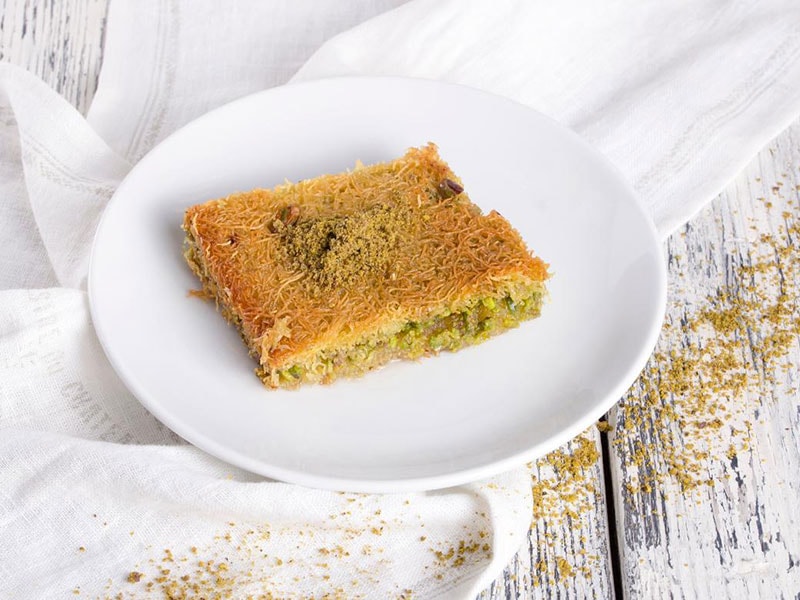
Kadayıf, an enticing traditional Ottoman dessert, captivates taste buds with its perfect texture and rich flavors. Although the exact origins remain shrouded in mystery, Kadayıf is celebrated in multiple forms, such as Tel Kadayıf, Taş Kadayıf, and Ekmek Kadayıf.
To create this dessert, locals pour liquid wheat dough onto a hot, spinning plate, then sweeten it to the desired level. The dough is then either baked or fried and sometimes even transformed into a base for pudding or made into noodles.
For your information, Tel Kadayıf is a beloved choice during Ramadan, where Kadayıf noodles sandwich a filling of walnuts or peanuts. Taş Kadayıf (Stone kadayıf) are presented as sweet dumplings filled with walnuts for Ramadan dessert.
As a matter of fact, Adana Taş Kadayıf was recognized with a geographical indication in 2021.
7. Baklava (Layered Pastry Dessert)
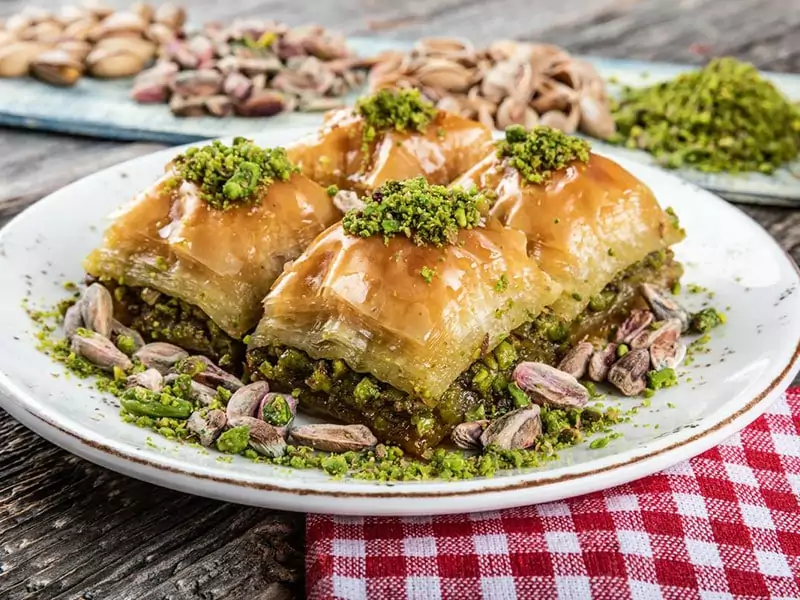
The word “baklava” is believed to have its roots in the Mongolian term baγla- which means ‘to tie, wrap.’p, pile up’. As a dish, it boasts numerous regional variations, each with its own unique twist and flavor combination.
Originating from Ottoman cuisine, Baklava has become a common delicacy in Iranian, Turkish, and Arab cuisines. This sweet treat holds a special place in celebrations, weddings, and holidays, where it is eagerly prepared and savored.
Also, Baklava is a beloved layered pastry dessert consisting of delicate filo pastry generously filled with chopped nuts. To add to that, locals sweeten it with a luscious honey or sugar syrup known as sherbet.
8. Turkish Coffee
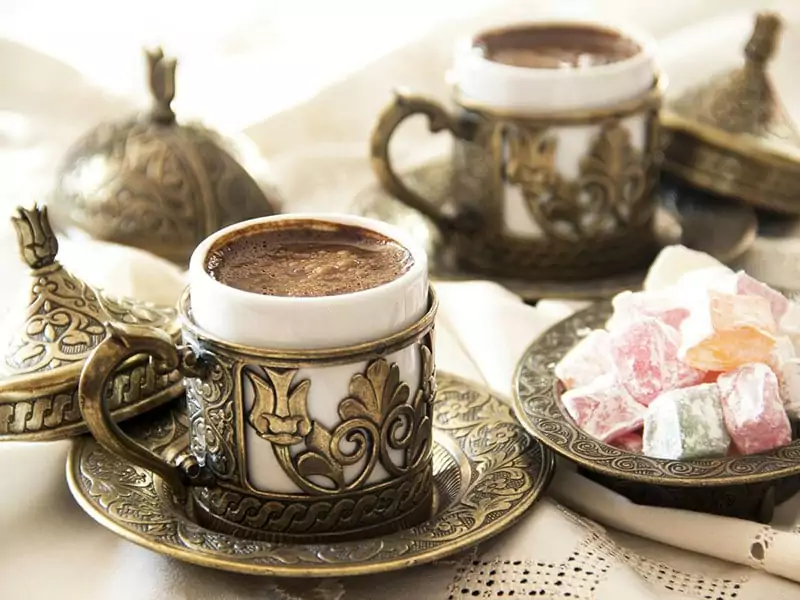
Turkish Coffee, a renowned gem of Middle Eastern cuisine, exudes warmth, flavor, and hospitality. Its preparation starts with a cezve, a specialized pot where very finely ground coffee beans, usually of high-quality Arabica variety, mingle with water and sugar.
Without filtering, the blend is boiled to perfection in the cezve. The level of sweetness varies, ranging from unsweetened to moderately sweet or fully sweet. Plus, you can enhance Turkish coffee with cardamom, ambergris, salep, or mastic flavors.
One standout characteristic is that it is always served with a small, sweet accompaniment. It can be a piece of Turkish delight or chocolate, perfect for balancing the strong, rich coffee flavors. The coffee symbolizes hospitality, predominantly enjoyed after meals or while entertaining guests.
9. Shawarma (Roasted Meat)
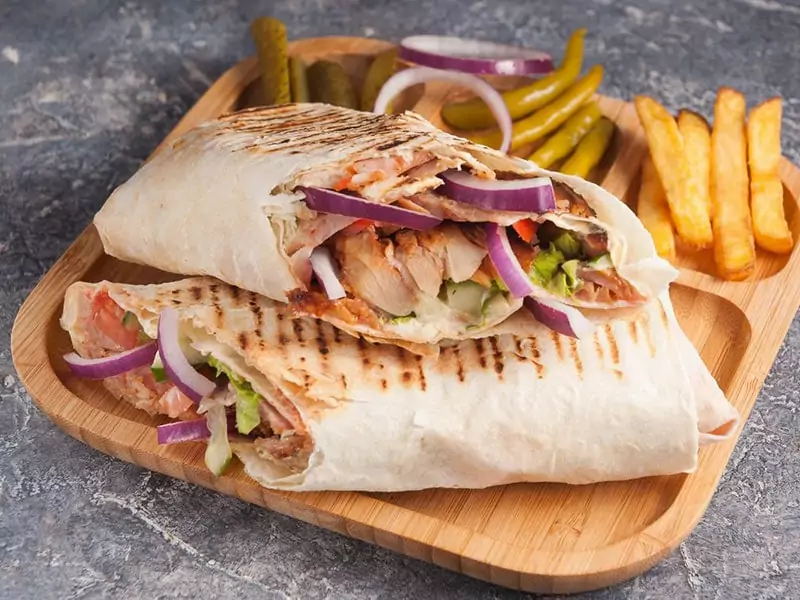
Meet Shawarma, a savory Turkish street food classic with roots traced back to the Ottoman Empire. This culinary wonder utilizes meat cut into thin slices and artfully stacked into an inverted cone shape, then roasted on a slow-turning vertical rotisserie or spit.
Then, the thin meat slices are carefully carved off the cooked surface using a long, flat knife as it continuously rotates. The first use of this technique dates back to the 19th-century Ottoman Empire.
Shawarma can be quite versatile when made from meats like mutton, lamb, chicken, beef, turkey, or veal. Seasoned with a fragrant mix of spices, including cinnamon, cumin, cardamom, turmeric, paprika, and sometimes baharat, Shawarma pairs nicely in a sandwich or a wrap (using flatbread).
10. Shish Tawook (Grilled Chicken Skewer)
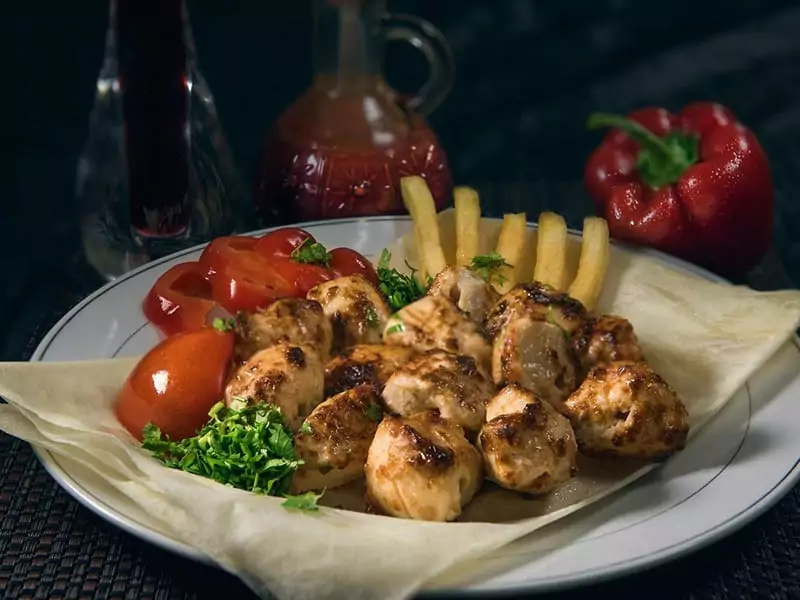
Shish Tawook, a classic chicken kebab dish, is a beloved recipe from the kitchens of Ottoman cuisine, widely enjoyed in the Middle East and the Caucasus.
The recipe involves marinating chicken cubes, which are then grilled on a skewer, earning the ‘ame ‘Shish,’ a term that signifies ‘skewer’ in Syrian-Arabic dialects and Turkish.
Yogurt, tomato puree, and lemon juice are the main base of the marinade, creating a fusion of tangy, savory flavors. Also, this versatile dish lends itself to various serving styles, including a sandwich filling or a standalone entrée on a platter accompanied by vegetables.
A traditional Turkish serving style will pair Shish Tawook with yogurt, rice, skewer-grilled vegetables, and a cucumber salad. Beyond Turkey, Shish Tawook’s fame has reached Lebanon, Egypt, the Gulf region, Iraq, and Syria, making it a beloved item.
Levant
11. Baba Ghanoush/ Baba Ghannouj (Eggplant Dip)
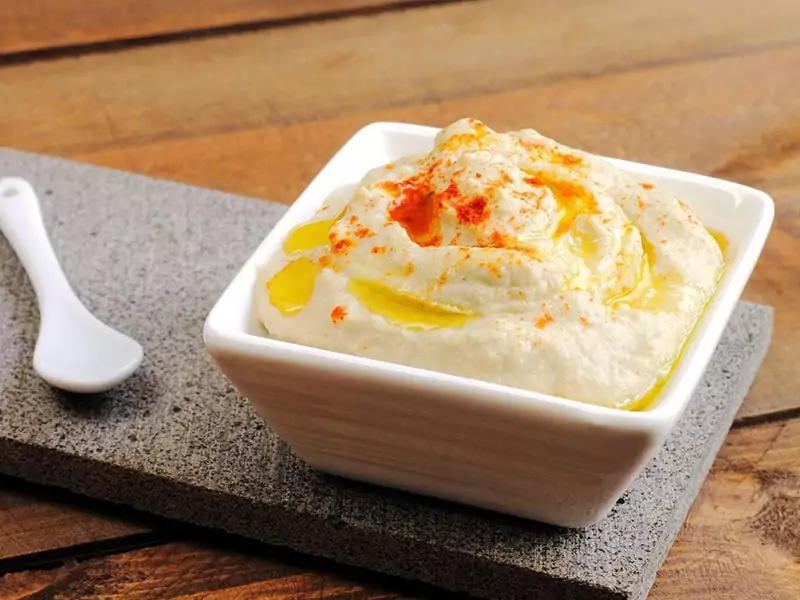
Journey to the Levant’s culinary culture by tasting Baba Ghanoush, an appetizer (meze) featuring eggplants as the star ingredient. With a delicious blend of finely chopped alongside roasted eggplant, lemon juice, olive oil, tahini, and various seasonings, this dish offers a hard-to-forget experience.
Normally, the eggplant, either baked or broiled over an open flame, lends a smoky taste to the Baba Ghanoush. Surprisingly, Baba Ghanoush reminds me of Mutabbal, another spicier dip that might contain yogurt.
Both are wonderful accompaniments to main meals and perfect dips for pita bread. In Turkey, for example, the dish goes by the name babaganuş or abugannuş, while a very similar item in Romania is called salată de vinete.
12. Manaeesh (Cheese Pita)
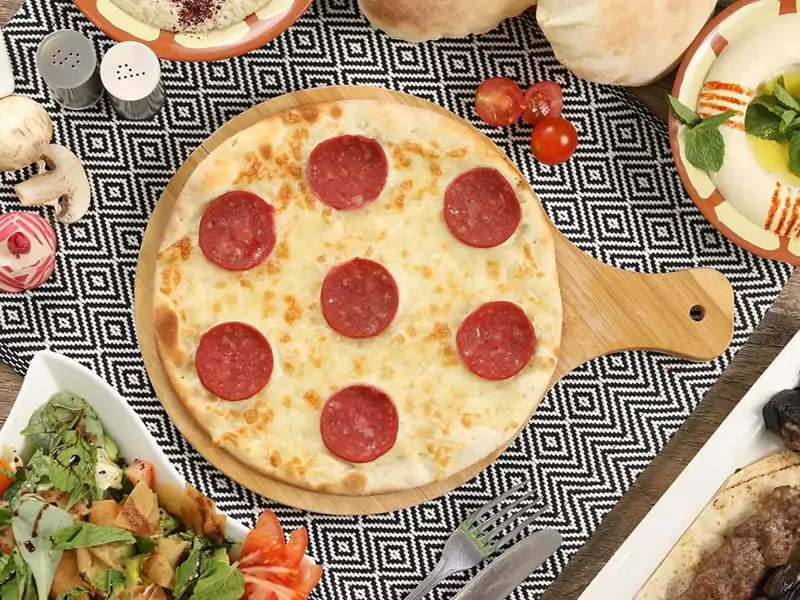
Manaeesh, also known as Manakish, is a delicious Middle Eastern flatbread with crispy edges and soft centers. This versatile dish mainly comprises dough adorned with toppings like cheese, ground meat, or thyme, then baked until golden.
The result is a delicacy that can be sliced like a pizza or folded for a convenient meal. Whether savored for breakfast or lunch, Manaeesh never disappoints. Make sure to try diverse toppings like Za’atar spice blend, minced lamb, chili, Kashk, or spinach for a fascinating spin.
13. Musakhan (Sumac Chicken With Onions And Flatbread)
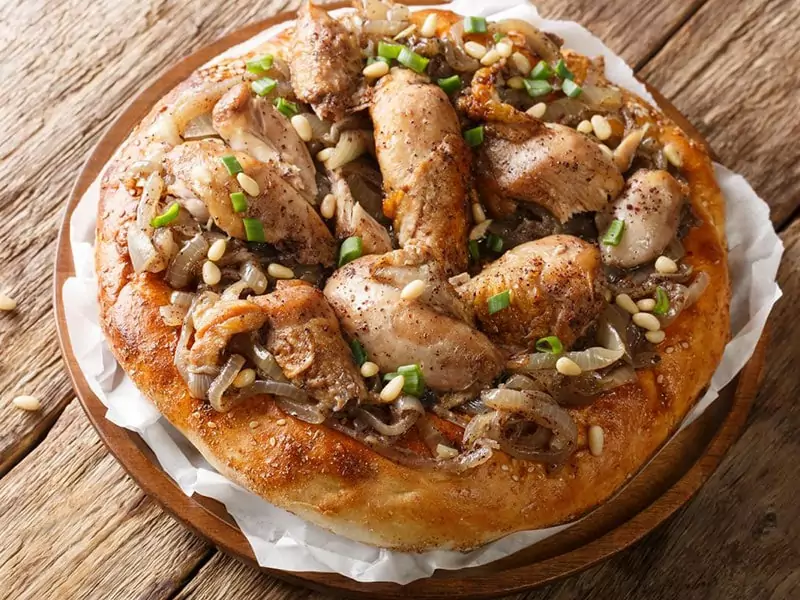
Musakhan, a national dish of Palestine, holds a special place in Palestinian cuisine, Jordanians, and Israeli Arabs alike. This culinary creation comes from the Tulkarm and Jenin area.
The preparation involves roasting chicken with a mouthwatering medley of sumac, allspice, saffron, onions, and fried pine nuts; all layered on taboon bread. As a symbol of celebration, particularly during the olive harvest season, especially with soup dishes.
Musakhan is usually eaten with hands and savored bit by bit. Its simplicity and the accessibility of ingredients likely contribute to its immense popularity.
14. Fattoush (Levantine Green Salad)
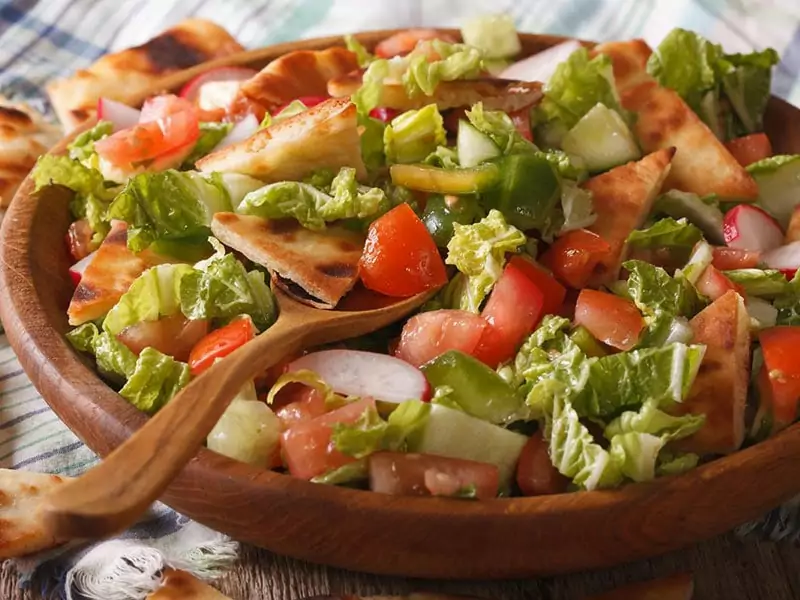
Fattoush, a vibrant Levantine salad, harmoniously merges toasted or fried khubz (pita bread) with mixed greens and fresh vegetables, including succulent tomatoes and crisp radishes.
Coming from the Fattat cuisine family, this refreshing salad utilizes stale flatbread as the base. Furthermore, the allure of Fattoush lies in its adaptability, with vegetables and herbs varying depending on the season and personal preference.
Notably, all ingredients are cut into large pieces, enhancing the textural experience. A dusting of sumac, known for its tangy flavor, is a cherished component of this salad. Sometimes, people even complement it with a drizzle of pomegranate molasses for a sweet and sour note.
15. Mansaf (Jordanian Lamb)
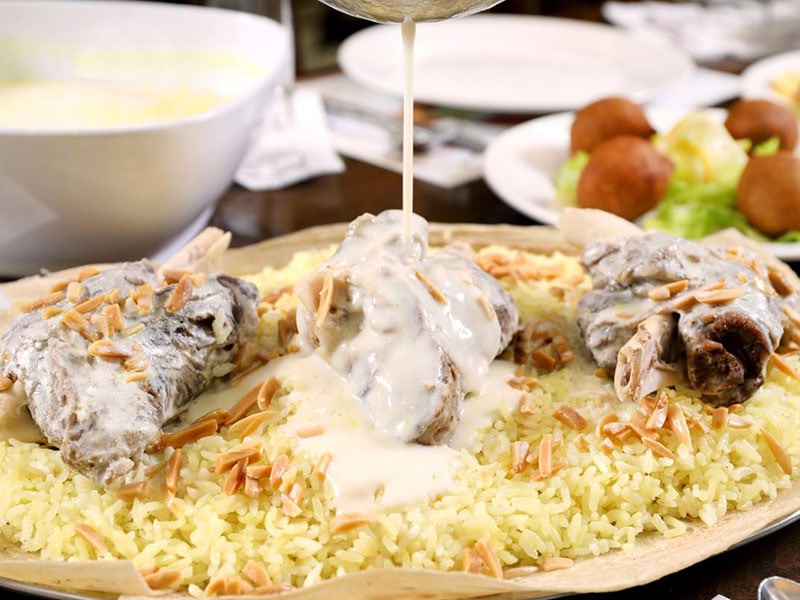
Mansaf, the national dish of Jordan, is a lovely lamb dish that you’ll also encounter in Saudi Arabia, Kuwait, and Syria. As for the meaning, the name Mansaf translates to “large tray” or “large dish,” hinting at a large feast.
This prime Jordanian food features succulent lamb, gently cooked in a tasty sauce made from fermented, dried yogurt called Jameed. This meaty delight is then harmoniously served over a bed of bulgur or rice, adding a pleasant, hearty texture.
In the 20th century, Mansaf evolved significantly, cementing its status as a centerpiece of celebratory meals. Weddings, graduations, births, and major holidays like Christmas, Easter, Jordan’s Independence Day, and Eid ul-Fitr, all become extra special with a serving of Mansaf.
16. Freekeh
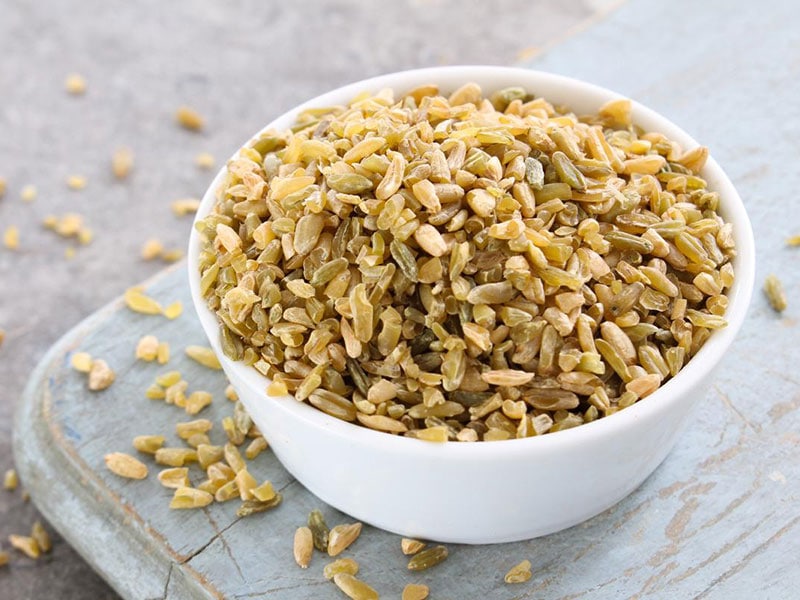
Freekeh, derived from the word “rubbed,” can sometimes be spelled as Frikeh or Farik. This cereal food recipe originates from the Levantine and North African cuisines.
Preparing Freekeh is fascinating, as green durum wheat is harvested, piled, and sun-dried. This meticulous rubbing process creates a uniform flavor, texture, and color for the durum wheat grains.
The dish has also appeared in many countries. For instance, in Egypt, Freekeh is the star ingredient in ḥamām bi’l-ferīk, a delicacy of pigeons stuffed with green wheat.
Over in Tunisia and Algeria, they incorporate Freekeh into a tomato-based soup called chorba’t frikm. In Turkey, where it’s called Firik, locals sell it across the country in market areas.
17. Kibbeh Nayyeh (Raw Seasoned Ground Meat)
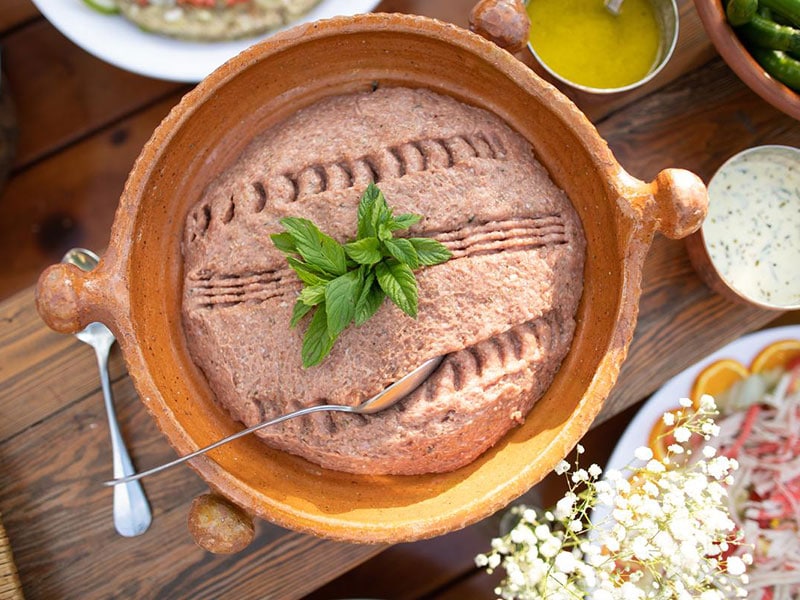
Kibbeh Nayyeh, a classic component of Lebanese cuisine, is a popular part of the mezze tradition. This dish is an interesting blend of raw minced lamb, fine bulgur, and an array of seasonings.
People often drizzle extra olive oil and sprinkle fresh mint leaves with green onions to enhance the flavor profile. To enjoy Kibbeh Nayyeh, I suggest scooping this mixture using pieces of pita bread. But, the versatility of Kibbeh Nayyeh doesn’t stop there.
It can morph into a shell for cooked kibbe, filled with a concoction of lamb, spices, onions, and pine nuts, then fried to perfection.
Especially cherished by Christians in the Middle East, Kibbeh Nayyeh graces both everyday tables and holiday feasts, such as Christmas and Easter. Always keep in mind to practice utmost care when preparing and savoring this raw delight.
Armenia
18. Harissa (Armenian Wheat and Chicken Porridge)
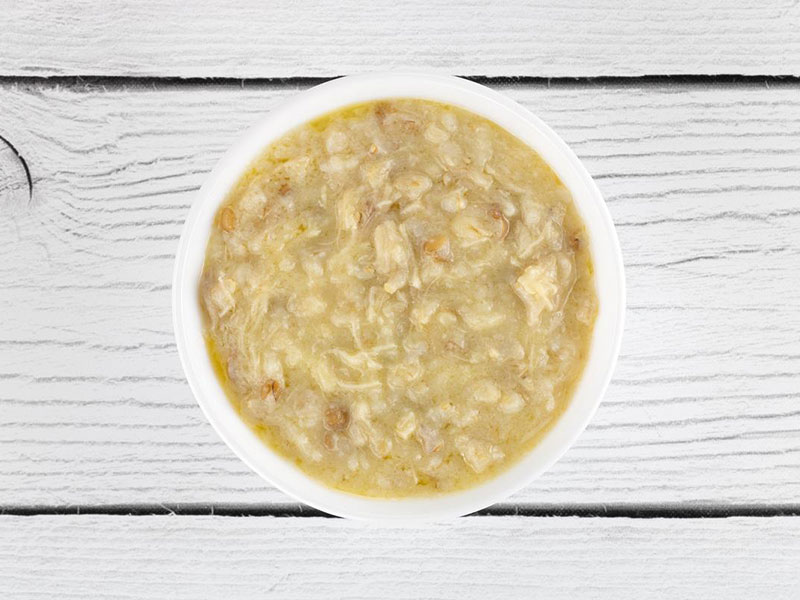
Harissa holds a significant place in Armenian culinary culture of being a national dish. This delicacy is a thick porridge, with a consistency like a gruel, created from either boiled, cracked, or coarsely-ground wheat, known as korkot.
It traditionally incorporates chicken or lamb, contributing to a high-fat content, although herbs may be used as an alternative on religious days. Notably, Harissa is prepared through a long cooking process.
Also, the dish frequently appears on Easter day and is offered as a charity meal to those in need. It is also said that Gregory the Illuminator, the patron saint of Armenia, introduced the preparation of Harissa to the poor people.
During the 1915 resistance of the Armenians of Musa Ler, Harissa was pivotal to people’s survival.
19. Manti (Dumplings)
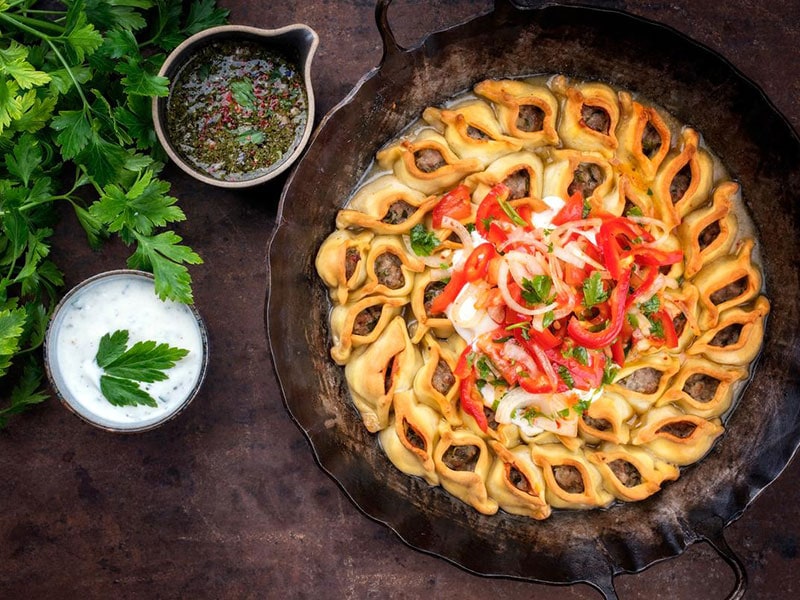
Manti, or Monta, is a renowned Armenian dumpling dish. Differing from Central Asian counterparts, these dumplings are typically smaller and are always baked to achieve a distinctive crunchy texture. However, other countries may also boil or steam these dumplings.
Additionally, it’s commonly enjoyed with either Matzoon, a local-style yogurt, or Taser, a sour cream, for a tangy touch. Also, a touch of garlic often elevates the whole eating experience.
Commonly, people often serve Manti with Mantapour, a clear soup that harmoniously rounds off the meal. It’s important to note that Manti is more prevalent among Western Armenians, whereas Eastern Armenians and Georgians often gravitate towards Khinkali, a different dumpling variant.
Morocco
20. Tajine (Savory Stew)
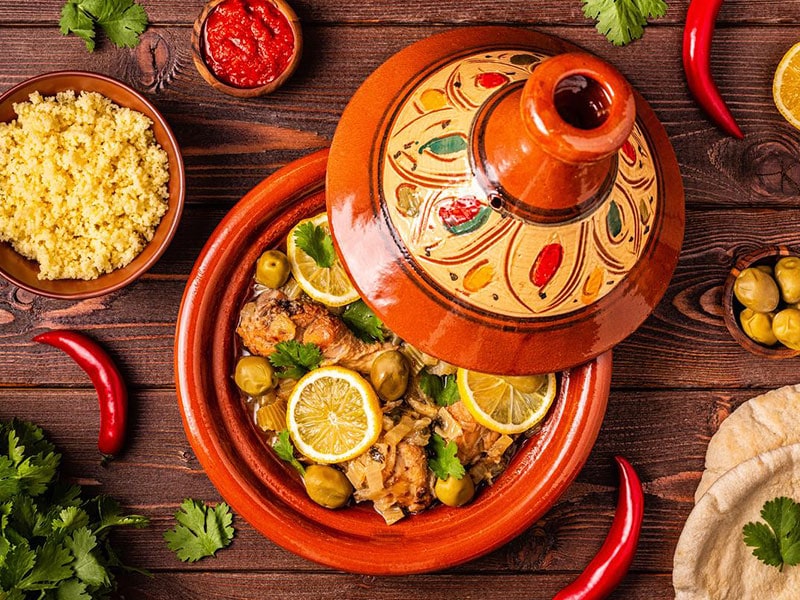
Named after the distinctive earthenware pot it’s cooked in, Tajine is a slow-cooked stew that draws a connection to the times of Harun al-Rashid, the fifth Abbasid Caliph.
The pot’s unique design, with a domed or cone-shaped lid, allows the stew to cook with minimal water, creating intense, concentrated flavors. Ingredients of Tajine are versatile, ranging from poultry, meat, and fish to fruits and vegetables.
You can include various nuts, spices, or dried fruits, amplifying the stew’s taste profiles. Also, common spices like ginger, cinnamon, turmeric, cumin, and saffron add warmth and depth, while chili and paprika lend a bit of heat to this time-honored Moroccan food.
A striking feature of Tajine dishes is the sweet and sour combination. As a traditional serving suggestion, Tajine is usually accompanied by bread to soak up the rich flavors. The cooking concept of Tajine, in fact, has been mentioned in the famous “One Thousand and One Nights”.
21. Ahriche (Tripe Skewer)
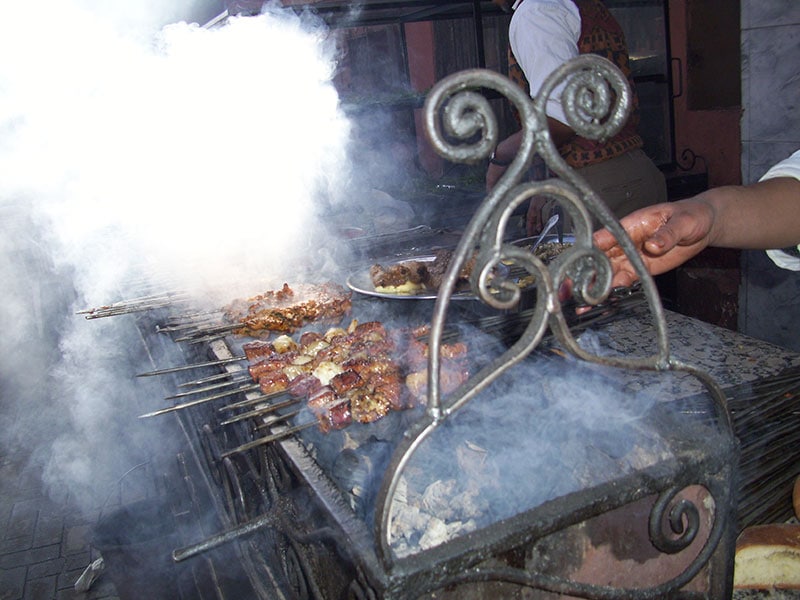
Ahriche, a dish whose name originates from the Berber word for ‘stick,’ signifies the special cooking method employed in its preparation. Commonly, the recipe consists of animal offal of caul, ganglion, heart, or lung that’s carefully wound with intestines.
This concoction is then skewered onto an oak stick and cooked over hot coals, infusing the ingredients with a smoky flavor. Normally, Ahriche is popular among the tribes of Zayanes and Khénifra.
22. Bichak (Stuffed Baked Tricorners)
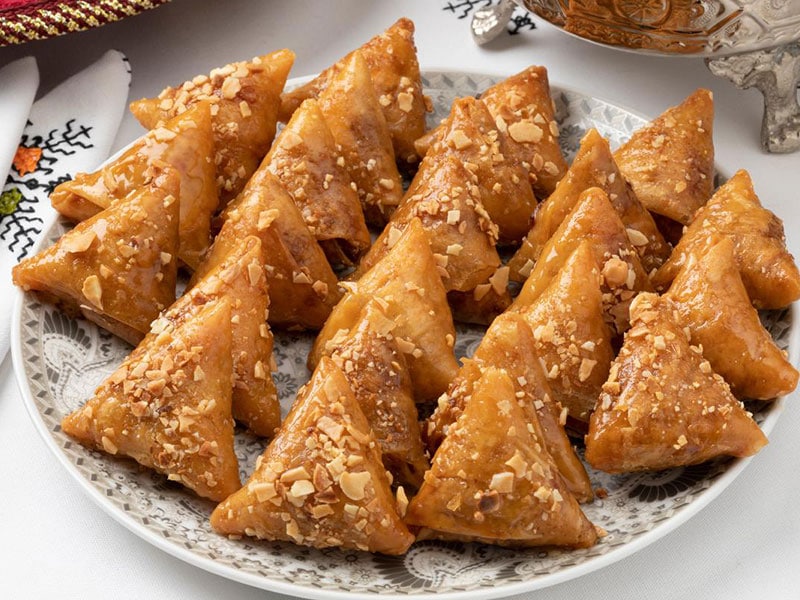
Bichak, a favored pastry from Central Asia, the Middle East, and notably Morocco, is an intriguing appetizer or a standalone meal. These pastries, molded into shapes from triangles to quadrangles, reminded me of turnovers but with a more innovative twist.
Typically, the sweet Bichak is a refreshing mixture of pumpkin, jam, and vegetables, while the savory version packs a heartening combo of meat and cheese. Bichak is not just an everyday dish; it also connects to Jewish celebrations like Rosh Hashanah and Sukkot.
Savoring these during tea or coffee hours is pure joy. Plus, they are a hit in large gatherings due to the ease of mass preparation. A highlight for kosher dairy meals, Bichak stuffed with cheese or pumpkin, alongside sour cream or yogurt, is a gastronomic delight.
23. Briouat (Puff Pastry)
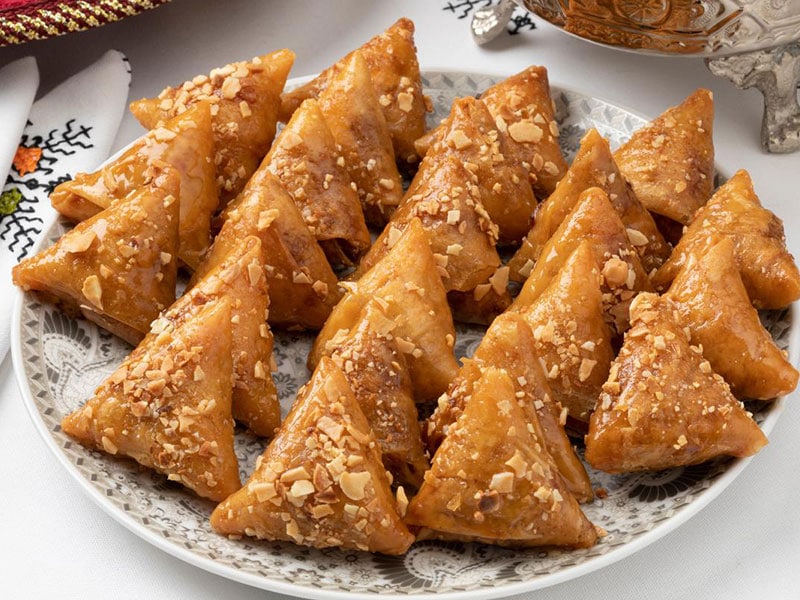
Briouat, a savory or sweet treat from the Moroccan kitchen, captivates me with its iconic triangular or cylindrical shape. It’s a food artist’s dream, usually wrapped in a delicate, paper-thin dough called warqa.
With two versions of sweet or savory, Briouat can easily adapt to any meal. Most often, the sweet Briouat, filled with luscious peanut or almond paste, is fried and then dipped in honey flavored with orange blossom water.
On the other hand, the savory variant is just as delightful, filled with various proteins, like lamb, chicken, shrimp, or fish mixed with cheese. In addition, you can have a pinch of pepper and a twist of lemon for additional flavors.
Baked or fried, every Briouat is a flavor-packed parcel. For the finishing touch, a sprinkle of herbs and spices for the savory or powdered sugar for a sweet variation are my go-to options.
24. Harira (Moroccan Tomato, Lentil, And Chickpea Soup)
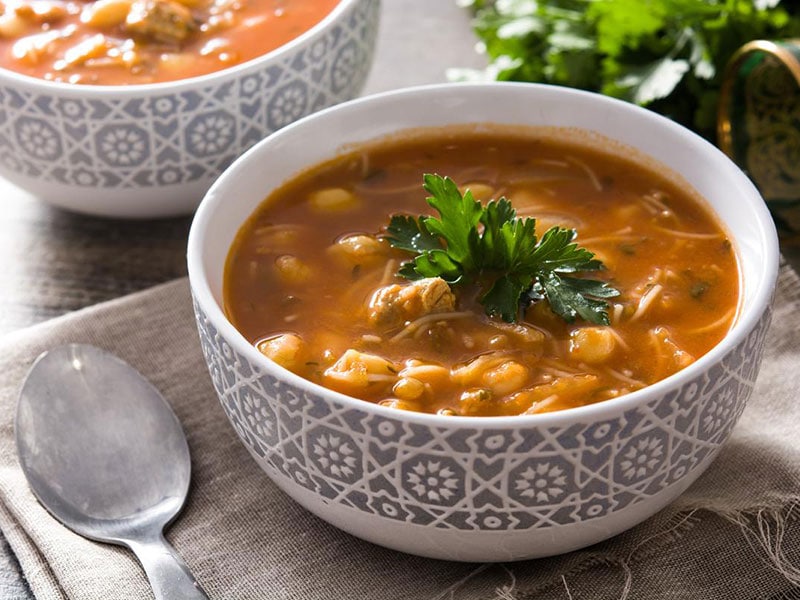
Harira, a traditional North African delicacy, has its roots in Morocco and Algeria. When I tasted the Algerian version, there was an absence of lentils, unlike the Moroccan Harira, which gave it a special touch.
This soup can be enjoyed as a starter or even as a light snack on its own, and I’ve relished it in both ways. One thing I found remarkable about Harira is its variation.
Each bowl can differ slightly in taste, but the base often remains the same with tadouira, a thickener added towards the end of cooking, tomatoes, chickpeas, lentils, fava beans, rice, onions, eggs, meat, and a drizzle of olive oil.
Aside from being popular during Ramadan, Harira can also be a year-round staple. Serving suggestions are diverse, from accompanying the soup with hard-boiled eggs sprinkled with cumin and salt to pairing it with dried fruits, cumin, dates, or traditional honey sweets.
A bowl of Harira with homemade crepes or bread is also a great duo. From my personal experience, you can take this soup to the next level if you allow it to rest overnight.
25. Lavash (Flatbread)
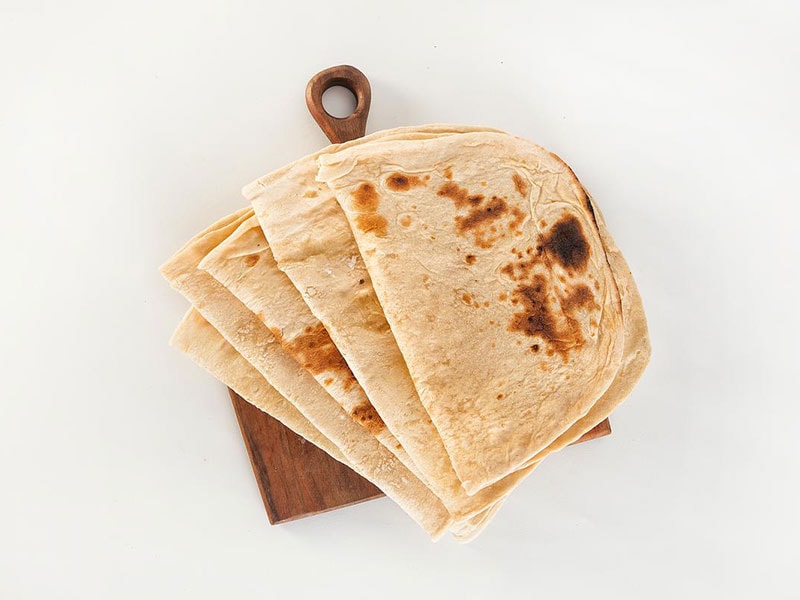
I had the opportunity to savor Lavash while bouncing between Middle Eastern countries. This iconic delicacy is a thin leavened flatbread with roots in Armenia, Iran, Azerbaijan, and Turkey.
The traditional baking methods include using a tandoor or a sajj, but modern-day adaptations have seen people using everyday kitchen staples like a griddle or wok. Usually, preparing Lavash involves a simple mix of flour, yeast, sugar, water, and salt.
For an unleavened version, just skip the sugar and yeast. As a personal tip, you should sprinkle the dough with toasted poppy or sesame seeds before baking, adding an extra layer of texture and taste.
When fresh, Lavash has great flexibility but can dry out quickly, becoming brittle and hard. However, a quick sprinkle of water can make it soft again. Crumbled dried Lavash, or khash, is another way to use this versatile bread aside from using it as a wrap for the Armenian specialty dish, khorovats.
In 2014, Lavash made its mark on the global culinary map when “Lavash, the preparation, meaning, and appearance of traditional bread as an expression of culture in Armenia” was added to the UNESCO Representative List of the Intangible Cultural Heritage of Humanity [1].
Iran
26. Halvah (Middle Eastern Confection)
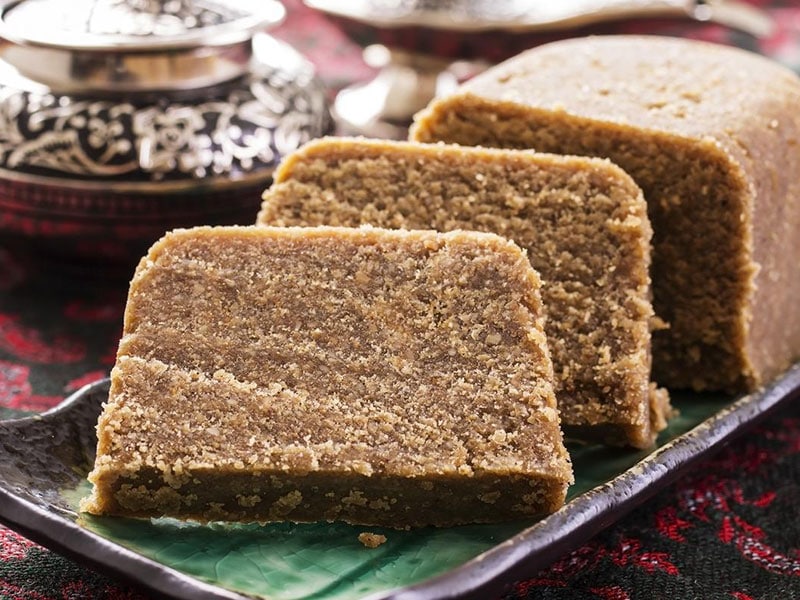
Halvah is a confectionery that originated in Persia and has become a favorite in countries like Iran, the Middle East, India, and Greece. It presents itself in a myriad of shapes and sizes, with most types being fairly dense.
The base of Halvah is a thick, sweet paste. Ingredients include butter, flour, oil, milk, cocoa powder, liquid oil, and saffron. The sweetness comes from honey or sugar, providing a satisfying treat for those with a sweet tooth.
As for the texture, Halvah can vary widely. For instance, grain-based Halvah, which uses flour or cornstarch, has a lovely crumbly texture that I particularly enjoy. Semolina-based Halvah is another popular variety; it can be buttery, moist, or even translucent and gelatinous.
If you fancy something a bit drier and crumblier, you might appreciate sesame-based Halvah. There are also other intriguing variations of Halvah made from sunflower and peanuts, each bringing its unique flavor profile.
27. Borani (Spinach And Yogurt Appetizer)
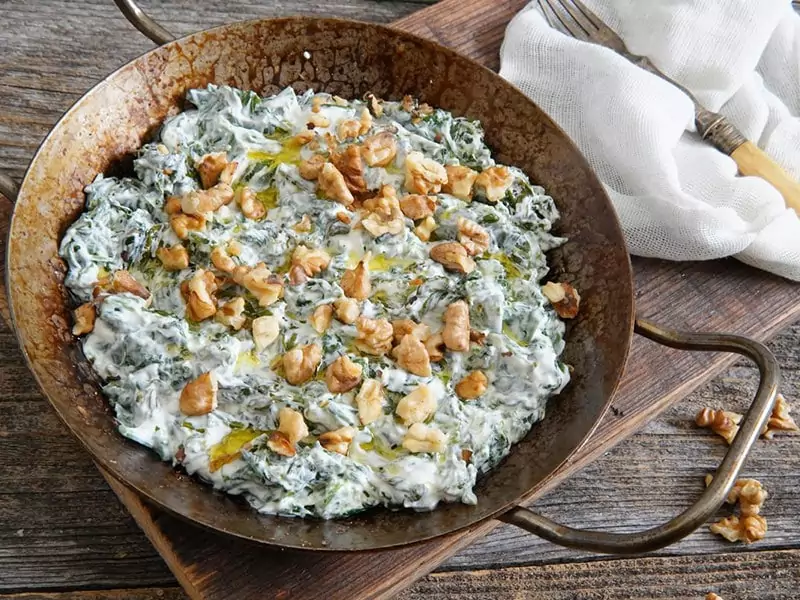
Borani is a beloved appetizer hailing from Iranian cuisine. Originally crafted with eggplant by Persion, today’s Iranian version introduces spinach, onions, and yogurt. You may find Borani simmered with a blend of spices, exuding aromatic flavor.
Interestingly, it also finds a place in Turkish cuisine, especially in provinces like Urfa, Isparta, and Van. In Urfa, they’ve put a twist on the traditional recipe, adding lamb and vegetarian meatballs. Also, this appetizer is great for pairing with crispy bread and a special butter sauce.
28. Kashk Bademjan (Persian Eggplant Dip)
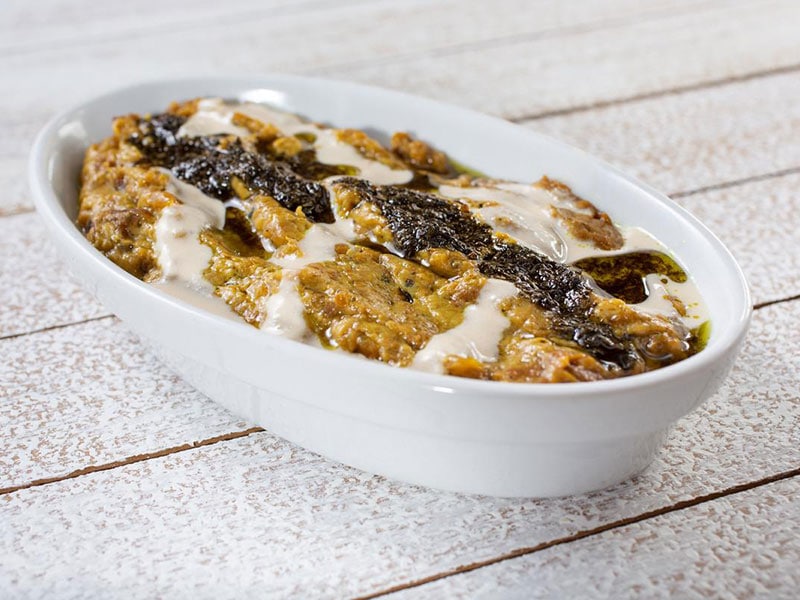
Kashk Bademjan, a Persian dish, lives up to its name with the starring ingredient, kashk. Despite the weird name, the delicacy is yogurt whey and eggplant. Served as a dip or potentially even a main course that is great for serving warm or at room temperature.
For garnish, I suggest mixing a concoction of saffron, garlic, sautéed onions, and walnuts. Its accompaniment is fresh bread, making for an enjoyable meal or snack. If kashk is hard to come by, you can use sour cream, Greek, or European yogurt to recreate this classic Iranian dish
Iraq
29. Kleicha (Iraqi Date Cookies)

Kleicha, a type of Middle Eastern cookie, is a special national cookie of Iraq and an integral part of Iraqi foods. There’s an appealing variety to Kleicha as it takes on different shapes and fillings, but the ones packed with dates are a hit among many.
Also, these treats come in sweet discs or half-moons that conceal a mix of sugar, nuts, and desiccated coconut. What ties them all together is the flavorful cardamom flavor, sometimes with a hint of rose water.
Ideally, you want to give them an egg wash for a beautiful color. Commonly, festive occasions such as Eid al-Fitr and Eid al-Adha are times for Kleicha in Iraq and Saudi Arabia.
Weddings and special ceremonies are also where you can find this treat, filled with everything from pistachios and walnuts to dates and Turkish delight.
30. Masgouf (Iraqi Grilled Carp)
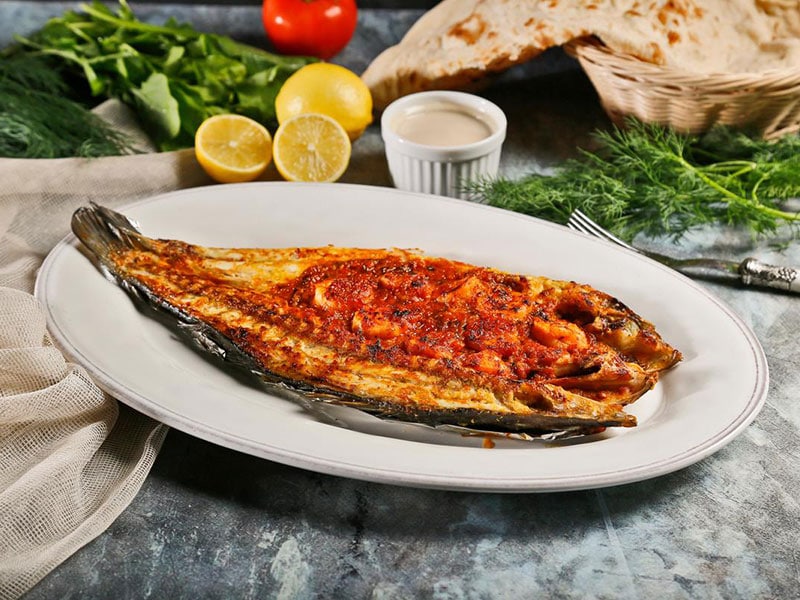
The centerpiece of many a convivial gathering in Iraq, Masgouf is a dish that warms the soul and ignites the taste buds. This Mesopotamian marvel of grilled carp holds the prestigious title of Iraq’s national dish, with the bustling streets of Baghdad known to produce the best Masgouf.
Particularly in the Abu Nawas district, I have found a veritable homage to this dish. To prepare Masgouf, you want to butterfly and marinate the freshwater carp before skewering it for a slow, tantalizing grill next to an open fire.
While waiting, anywhere between one and three hours, guests can ease their hunger by sharing mezes among loved ones. Once the feast begins, the flavorful carp is complemented beautifully by freshly baked naan bread, grilled vegetables, tangy tomatoes, and a punchy onion sauce.
Egypt
31. Fesikh (Fermented Fish)
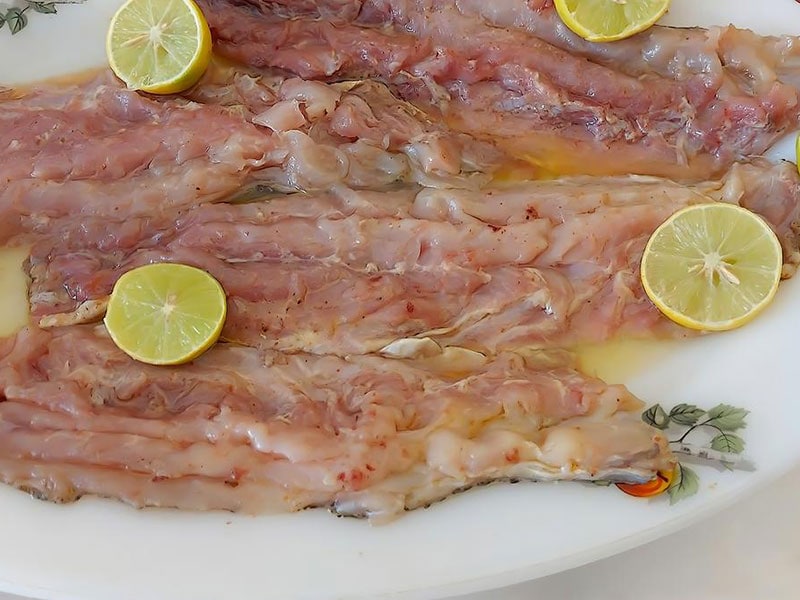
Fesikh is an age-old Egyptian traditional dish that takes center stage during the Sham el-Nessim festival. This fish recipe, lovingly prepared by generations, utilizes salted pickled fermented and dried gray Mullet, a saltwater fish.
Although Egyptians living in the West have sometimes turned to whitefish as a substitute, the original recipe’s authentic flavors remain unmatched.
Now, it’s worth mentioning that Fesikh comes with a fair warning from the Egyptian Ministry of Health, as the preservation process could lead to botulism poisoning. Fesikh can be risky to consume, no doubt, but the deep-rooted love for this dish sees Egyptians returning to Fesikh for more [2].
32. Ful Medames (Egyptian Fava Beans)
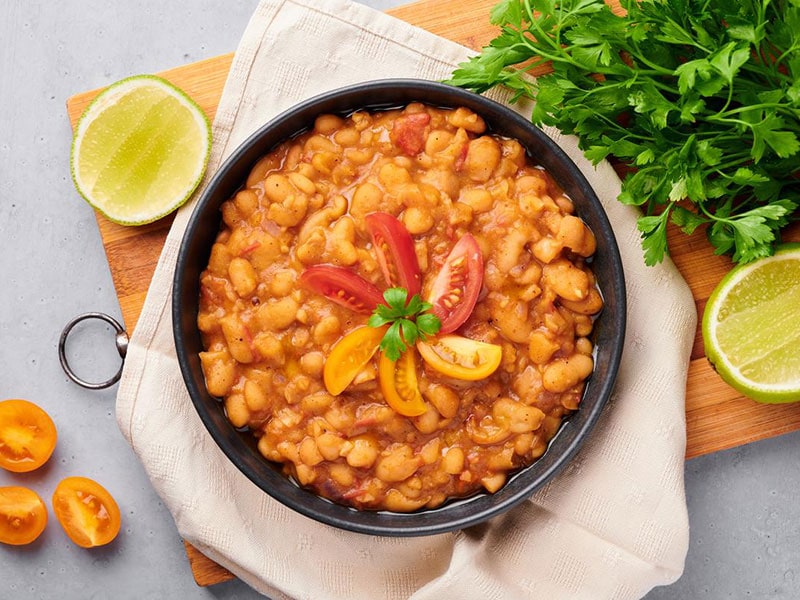
Ful Medames has roots deep in Egyptian culture, cherished as a national dish and referred to as a “gift from God”. It’s a hearty stew starring cooked fava beans or, as the locals call it, fūl ḥammām.
Surprisingly, the fascinating history of this dish travels back to Ancient Egypt, and its popularity has crossed boundaries, making its way to parts of the Arab world, Africa, and Asia.
The dish has an intriguing name of ‘Ful,’ translating to beans in Arabic, while ‘Medames,’ a Coptic term, stands for ‘buried’. Commonly, a drizzle of olive oil and a sprinkle of cumin add depth to the soup, while garlic, parsley, onion, chili pepper, and lemon juice form the iconic profile.
In Egypt, Ful Medames appears on many breakfast tables and lunch spreads, traditionally made in large metal jugs and paired with pita bread.
33. Hawawshi (Stuffed Pita)
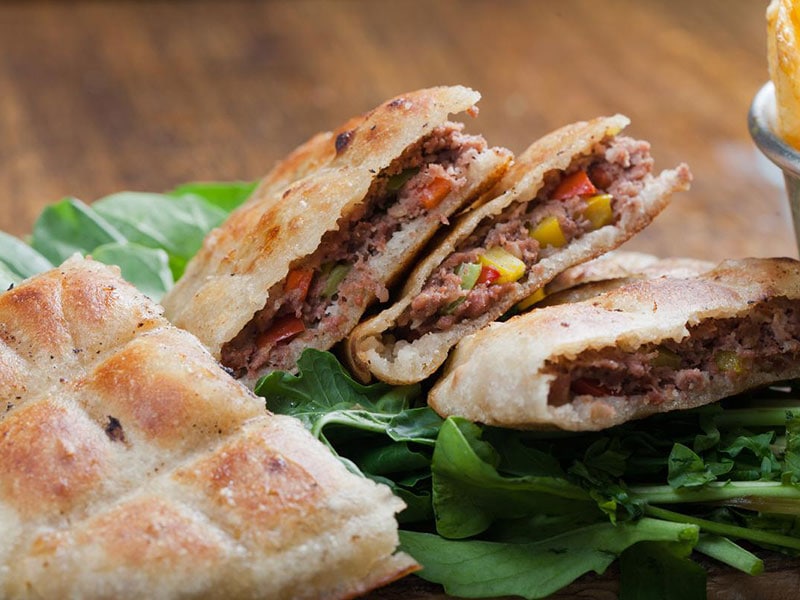
Hawawshi burst into existence in 1971, created by Ahmed al-Hawawsh, a Cairo butcher. The simplicity of Hawawshi is the main highlight, with a delicious blend of minced meat, pepper, onions, parsley, and occasionally chilies; all enveloped within a warm, soft pita bread.
There are two major variants of Hawawshi that have risen in popularity, baladi, and Alexandrian. The Alexandrian Hawawshi differs from the standard baladi due to the ingredients between two dough discs before being baked to perfection, with distinctive seasonings and spices.
Hawawshi has managed to cross borders, spreading its reputation throughout the Middle East and North Africa. In Egypt, both homes and restaurants frequently serve this dish as a quick, satisfying takeaway.
It is also a popular Egyptian street food, particularly in Alexandria and Cairo. Additionally, the dish is so loved that it sparks debates ensue about the best Hawawshi, with many pointing towards Sharqia Governorate in the Nile Delta.
34. Kushari (Egyptian Rice, Pasta, And Lentils)
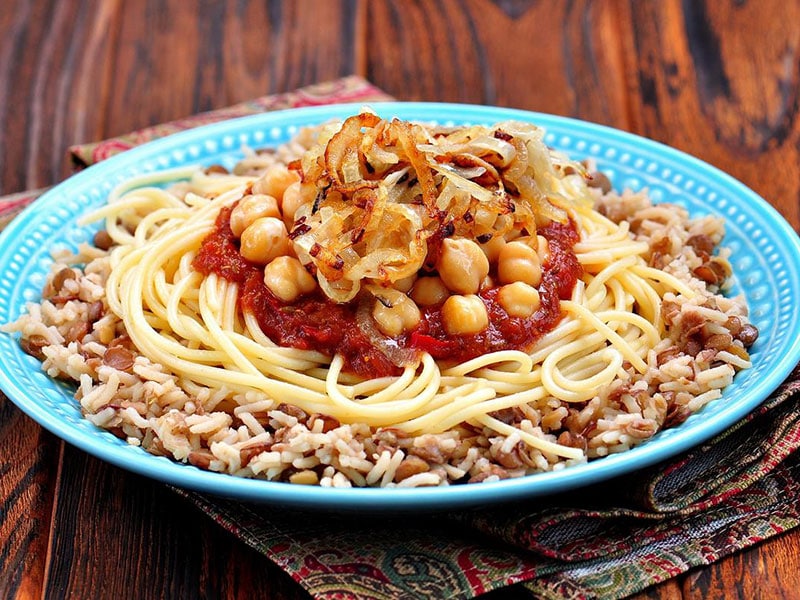
Kushari, Egypt’s national dish, has been filling the stomachs and warming the hearts of the Egyptian people since the 1800s. This dish was born from a frugal tradition where families combine the month’s leftovers into a luscious feast.
Its base is a medley of pasta, fried rice, brown lentils, and vermicelli. Also, it features a generous topping of garlic vinegar and tomato sauce for a tangy zing, while garnishing fried onions and chickpeas lends a beautiful crunch.
But wait, more flavor arrives with garlic juice and possibly a dab of hot sauce. Additionally, the Alexandria variant offers a unique take on Kushari, incorporating curry and cumin into the rice and pairing it with Egyptian rolled eggs, pickled tomatoes, and French fries.
35. Mulukhiyah (Jute Leaf Stew)
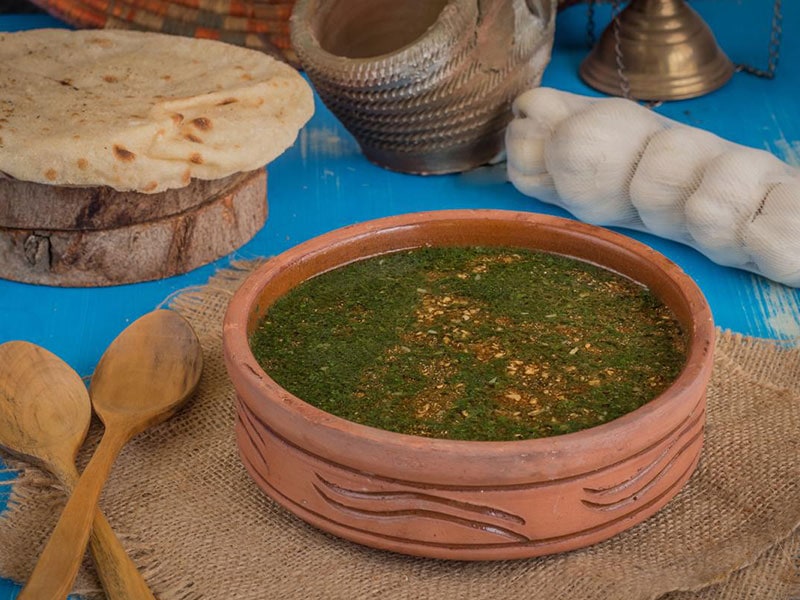
Mulukhiyah, a traditional Egyptian dish, incorporates the characteristics of Corchorus olitorius leaves, also known as jute mallow. When boiled, these leaves produce a thick, mucilaginous broth often likened to cooked okra due to its ‘slimy’ texture.
Despite being rather bitter, the leaves are great with other ingredients to create a comforting soup or stew. You can mix them with coriander and garlic to form a rich base for the dish, fortified with meat, ranging from chicken, lamb, rabbit, or shrimp in Alexandria.
On the other hand, Port Said is known for including fish in the mix. Served atop white rice or with Egyptian flatbread, Mulukhiyah is tasty with pickled vegetables, known as mekhallel or torshi. Also, you can use condiments such as vinegar and tomato sauce to customize the flavor.
Lebanon and Syria
36. Muhammara (Roasted Red Pepper Dip) – Syria
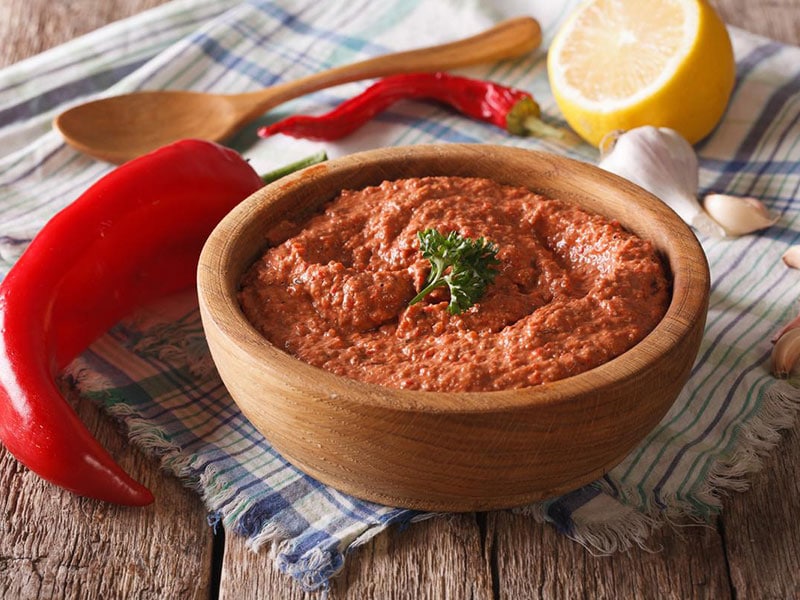
Muhammara, from Aleppo, is a vibrant and spicy dip that has also made its way to tables in Turkey and Armenia, aside from being in only Lebanon and Syria.
This tantalizing blend of roasted red bell peppers, crunchy walnuts, and breadcrumbs creates a pleasing texture to the palate. In addition, the inclusion of pomegranate molasses lends a subtly sweet and tangy note.
Muhammara’s versatility goes beyond being a mere dip savored with bread or a spread for toast. Its robust flavor complements grilled dishes remarkably well and is often served as a rich sauce for kebabs, fish, or grilled meats.
37. Tabouleh (Wheat And Herb Salad) – Lebanon and Syria
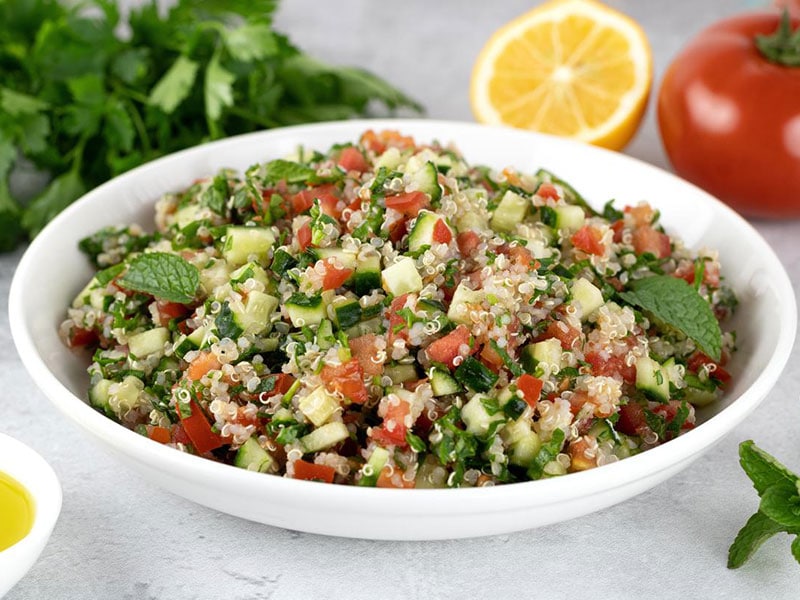
From the mountains of Lebanon and Syria, Tabouleh is a cherished Levantine salad that has become a favorite across the Middle East. This salad combines the fresh flavors of tomatoes, finely chopped parsley, mint, and onion with an excellent texture of soaked, uncooked bulgur.
To elevate these ingredients, you may season Tabbouleh with olive oil, salt, sweet pepper, and a zesty dash of lemon juice. Sometimes, lettuce or semolina can replace bulgur, changing the salad’s texture while maintaining its iconic flavor.
Once prepared, it’s served chilled. To honor Tabbouleh, Lebanese National Tabbouleh Day has been celebrated on the first Saturday of July every year since 2001.
38. Shanklish (Blue Cheese) – Syria and Lebanon
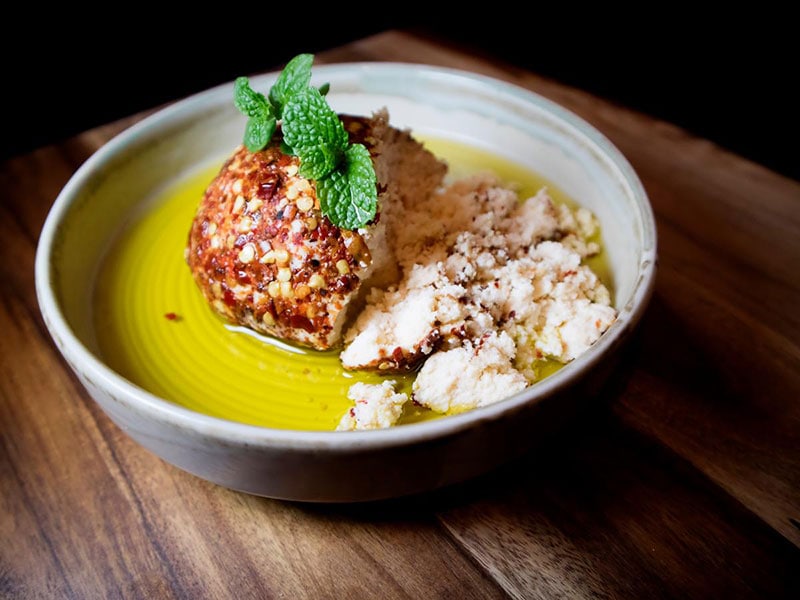
Shanklish, a blue cheese derived from cow’s or sheep’s milk, garners popularity in coastal and mountainous areas, especially around Homs and Tartous. The fresh variant of this cheese displays a soft texture and mild taste, but as it ages and dries, it transforms into a pungent, hard delicacy.
The aging process involves forming the cheese into balls, then coating them with Aleppo pepper, za’atar, and most commonly, thyme. Some prefer an added kick, introducing aniseed and chili into the mix, creating a spicier version recognizable by its red appearance, particularly in Syria food culture.
Some of the most delicious Shanklish cheese hails from around Tartus and Akkar. It’s versatile too – gracing dishes like Shʿifurah or Jʿifurah, where it’s mixed with finely-chopped tomato, olive oil, and onion.
Also, you may consider mashing the cheese with eggs or combining it in a pita with mint, cucumbers, and olive oil for breakfast. It’s also a reliable companion for araq and a star in the line-up of meze dishes.
Azerbaijan
39. Gürzə (Azerbaijani Dumplings)
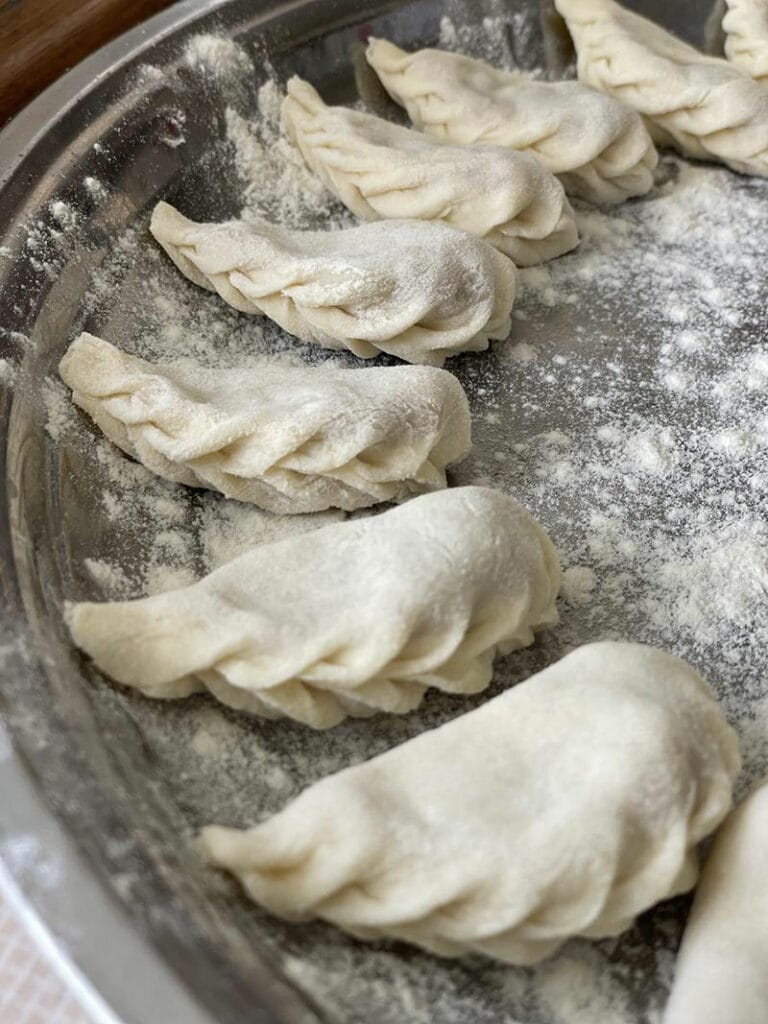
Gürzə is a distinctive member of Azerbaijani national cuisine, a variation of dumplings. The name “Gürzə” mirrors the Azerbaijani term for “Caucasian meadow viper”, a reflection of the wrapper sealing technique that mimics the intricate pattern on the viper’s skin.
These dumplings owe their flavor to a rich filling of pre-fried minced fatty lamb and onion tucked within a delicate thin dough wrapper. Once formed into small, open-top cylinders, they’re boiled and strained before serving.
Commonly, a dash of cinnamon often appears on these dumplings. You might also find Gürzə served with sour cream or yogurt blended with crushed garlic. Meanwhile, some culinary traditions transform these dumplings into a comforting soup, simmering them in lamb stock.
40. Dovga (Yogurt And Herb Soup)
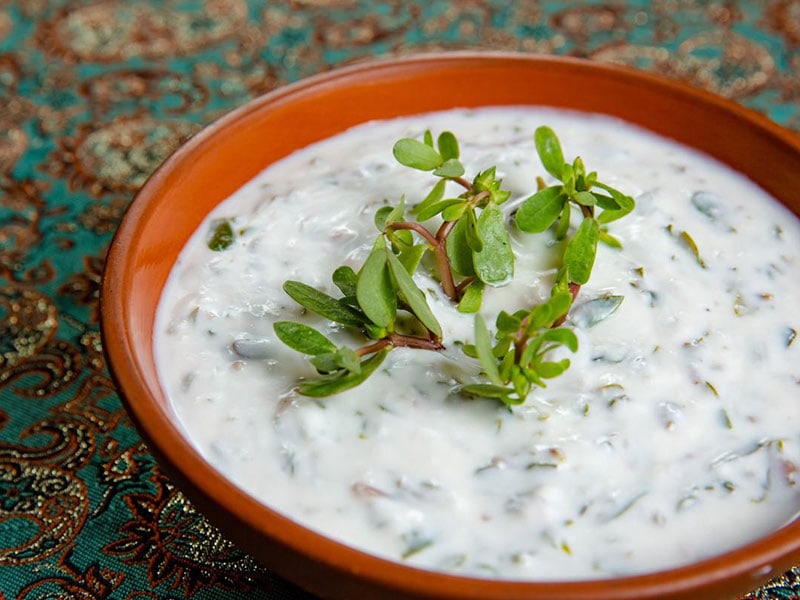
Dovga is a soup that elegantly brings together plain yogurt with herbs from exquisite Azerbaijani cuisine. It’s a vegetarian delight, with ingredients varying from region to region. Typically, Dovga brims with dill, coriander, mint, and spinach.
Other versions might also include chervil, scallions, sorrels, and mountain parsley in the soup mixture. Sometimes, additions like chickpeas, rice, or even meatballs make their way into this soup.
Traditionally a wedding soup, Dovga serves as a flavorful interlude between meaty courses, aiding digestion. Whether served warm in the summer or chilled in winter, Dovga has a way of suiting the season.
Plus, there’s also a variant known as Abdug in Southern Azerbaijan and Iran. Normally, Abdug skips rice for nuts, rose petals, and raisins, often served with ice in the summertime.
41. Qutab (Azerbaijani Flatbread)
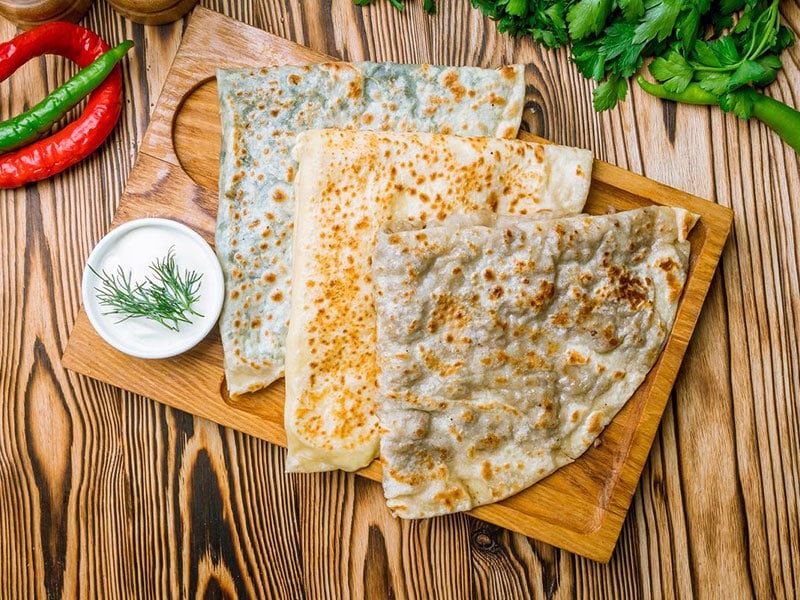
Qutab is the Azerbaijani flatbread crafted from dough rolled so thin it’s almost translucent. Commonly, the bread gets a quick cook on a saj for that iconic charred flavor. Inside is a delicious choice of fillings of tender lamb, sweet pumpkin, or green vegetables.
Qutab isn’t a main meal but a savored snack, a tasty item between larger feasts. Once cooked, people often slice the bread into smaller triangles, with a good butter drizzle for a glossy finish. For serving, pair it with cool, creamy yogurt and a sprinkling of fennel, sumac, and green coriander.
Cyprus
42. Fasolada (White Bean Soup)

Fasolada, a white bean soup, stands out in Mediterranean cuisines with its Greek, Cypriot, and ancient roots. It has a place of honor in Greek mythology, as the legend tells it was served in tribute to Apollo at the Pyanopsia festival.
The delicacy simply employs white beans, a generous amount of olive oil, and vegetables. Also, people usually pick tomatoes, onions, carrots, parsley, bay leaf, and celery. In fact, Fasolada is so beloved; it’s often touted as the Greeks’ national dish.
Sometimes, you might find Lima beans with traditional white beans or variations with added meat.
43. Souvla (Cypriot-Style Barbecue)
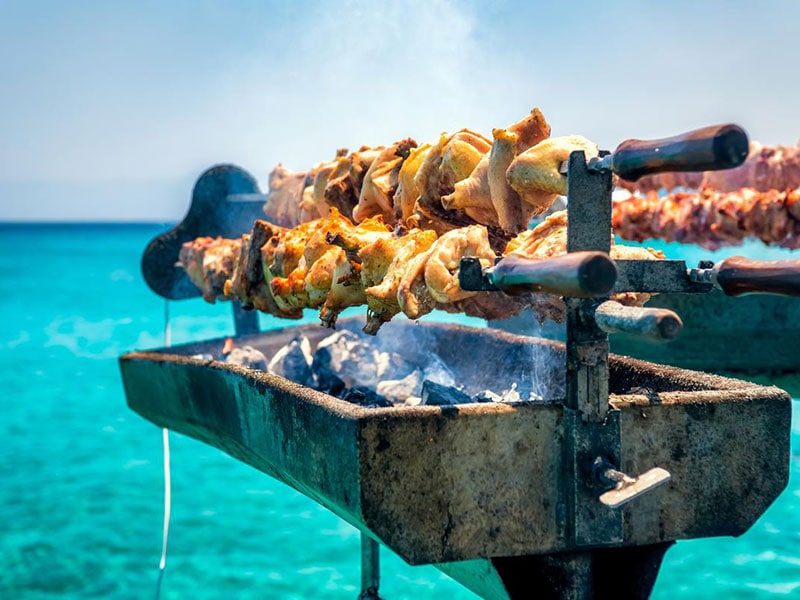
Souvla is a delightful Cypriot dish that showcases seasoned and marinated large pieces of meat. Typically made with pork, lamb, or chicken, this culinary gem brings joy to special occasions like Easter and Christmas.
The magic begins as the meat is skewered and slow-roasted over an open fire, infusing it with irresistible flavors. To achieve that tender and succulent texture, the meat is placed on a traditional charcoal brazier called a “foukou.”
Souvla is often lovingly basted as it roasts, enhancing the taste and texture to perfection. Souvla’s larger meat cuts and the extended cooking time are what sets it apart from its Greek counterpart.
Also, I’ve learned that positioning the meat at a greater distance from the hot charcoal allows Souvla to develop a tasty character. However, the cooking process may take longer.
44. Moussaka (Eggplant Casserole)
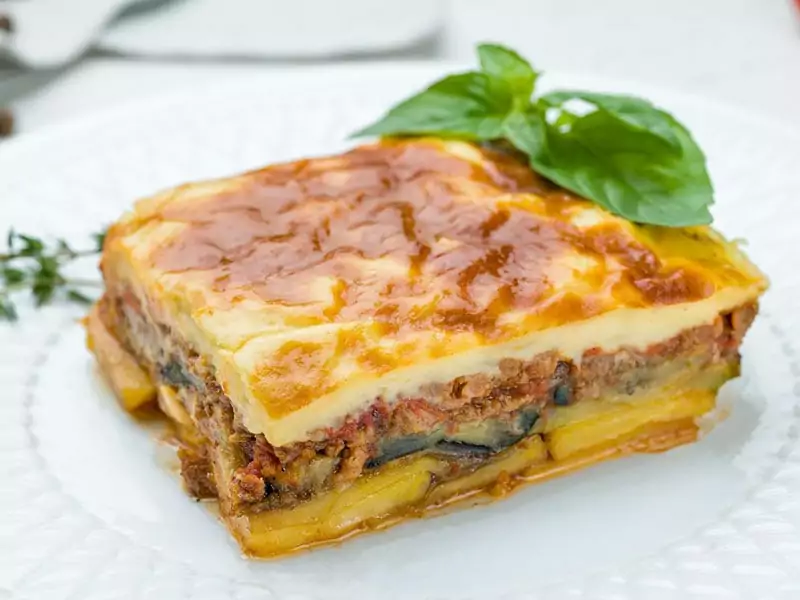
Moussaka, a main dish popular in the Balkans and the Middle East, boasts numerous regional variations. This savory casserole showcases layers of eggplants, seasoned meat (often lamb or beef), cheese, and spices.
Topped with a creamy béchamel sauce, locals bake Moussaka to golden perfection. To temper the eggplant’s bitterness, I suggest peeling and lightly seasoning it with salt. Some versions feature a tantalizing tomato sauce.
Other
45. Khuzi (Roasted Lamb Or Mutton) – UAE
Khuzi, also known as Ghuzi, is the national dish of the United Arab Emirates. This UAE culinary treasure consists of roasted lamb or mutton, elegantly placed on a fragrant bed of rice. Typically, the dish is generously garnished with vegetables and a sprinkle of nuts.
Furthermore, Khuzi is a delicacy reserved for special occasions and feasts, often taking center stage as the centerpiece during grand buffets and celebratory gatherings. While it may not be widely available, you can find it at select restaurants specializing in UAE cuisine.
46. Al Kabsa/Khabsa (Traditional Saudi Rice And Chicken) – Saudi Arabia
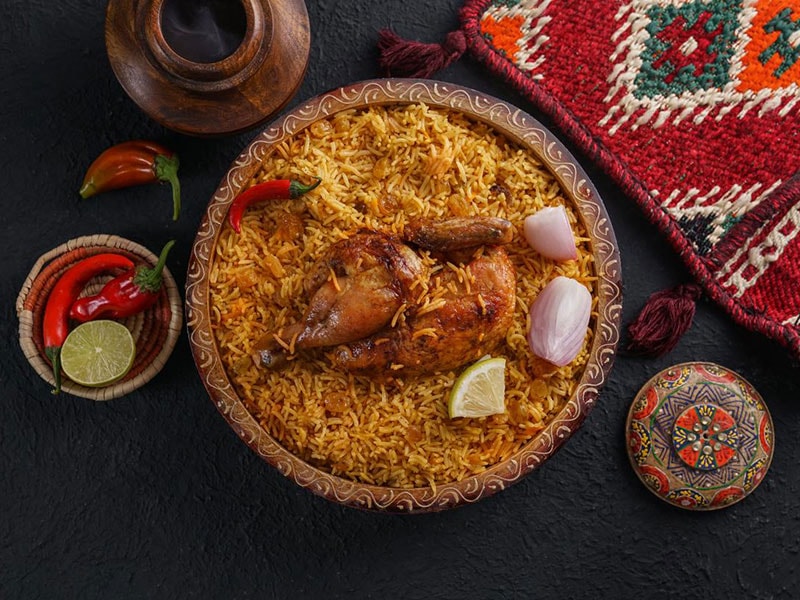
Al Kabsa, also called Khabsa, is a beloved mixed rice dish with various regional variations that is a national dish across the Arabian Peninsula.
The name “Kabsa” stems from the Arabic word “kabasa,” which means to press or squeeze, alluding to combining and cooking all the ingredients in a single pot. This mouthwatering Saudi Arabian dish showcases fragrant basmati rice, tender meat, vegetables, and a blend of spices.
The spice mixture often incorporates cloves, black pepper, cardamom, cinnamon, saffron, nutmeg, and bay leaves. Surprisingly, ready-made kabsa spice blends are available to simplify the cooking process.
While chicken is a common choice, lamb, beef, fish, camel, goat, and shrimp are popular. It’s worth noting that pork is forbidden in Saudi Arabia, being an Islamic state. Additionally, Bahrain has a national dish that is fairly similar to Al Kabsa, called Machboos.
47. Malawach (Yemenite Flatbread) – Yemenite Jewish
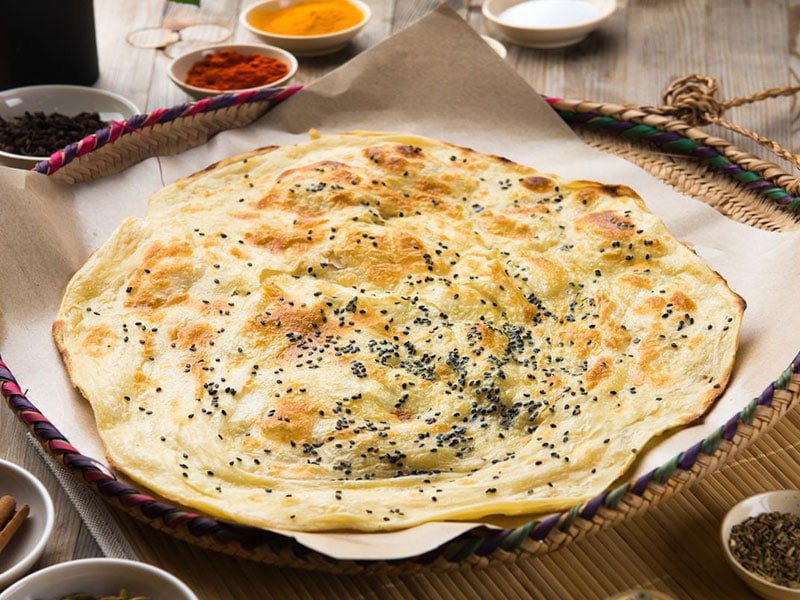
Malawach, a Yemenite Jewish specialty, is a delectable flatbread known for its board-like shape. Resembling a thick pancake, it consists of thin layers of puff pastry that are brushed with oil or fat before being cooked on a frying pan until golden and flaky.
Traditionally, this bread is served with zhug, a spicy sauce, hard-boiled eggs and a grated or crushed tomato dip. Occasionally, it is enjoyed with a drizzle of honey for a touch of sweetness.
Normally, Malawach is a homemade recipe within the Yemenite Jewish community, but it has now become a popular item served at restaurants throughout Israel.
This versatile flatbread is commonly used as a wrap, similar to a laffa, and pairs perfectly with savory fillings such as hummus, shakshouka, or sabich. Malawach also shines as a dessert when served with creamy labneh and a spoonful of jam.
48. Levengi (Fish Stuffed With Walnuts) – Azerbaijan, Iran
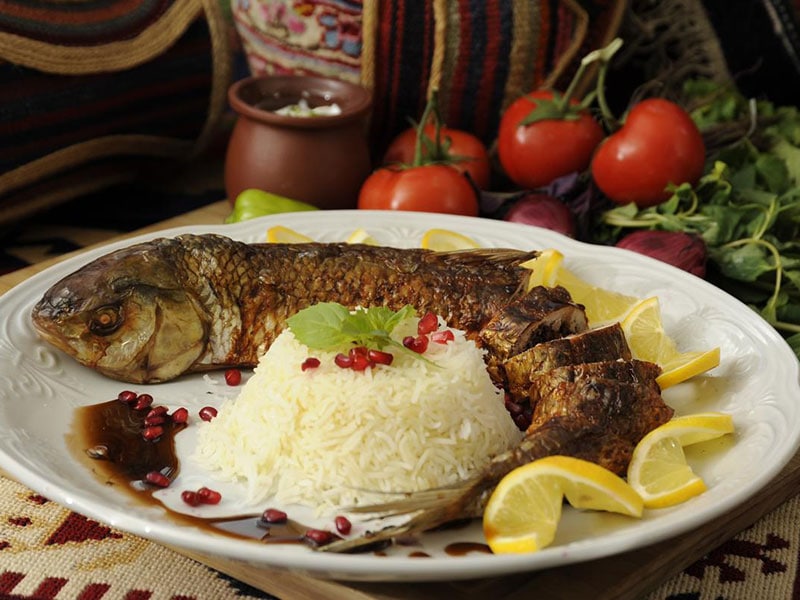
Levengi, a national dish of Azerbaijan, is a culinary gem also appearing in Talysh and Iranian cuisine. This flavorful treat involves stuffing fish or chicken with a mixture of onions, walnuts, and various condiments.
The dish is then lovingly baked in the oven until it reaches perfection. Additionally, Levengi can be prepared with duck or eggplant for alternative variations. Regarding stuffed fish (Balıq ləvəngisi), Caspian kutum, carp, or asp from the Caspian Sea are preferred choices.
In addition, beluga can also be used for a unique twist. The fish is traditionally served alongside bread, narsharab (pomegranate molasses), and lemon pieces, creating a harmonious blend of flavors.
Aside from that, the stuffed chicken (Toyuq ləvəngisi) is another popular variation of Levengi, often enjoyed with rice pilaf as a satisfying accompaniment.
49. Lahmacun (Turkish Pizza) – Levant, Turkey, Armenia
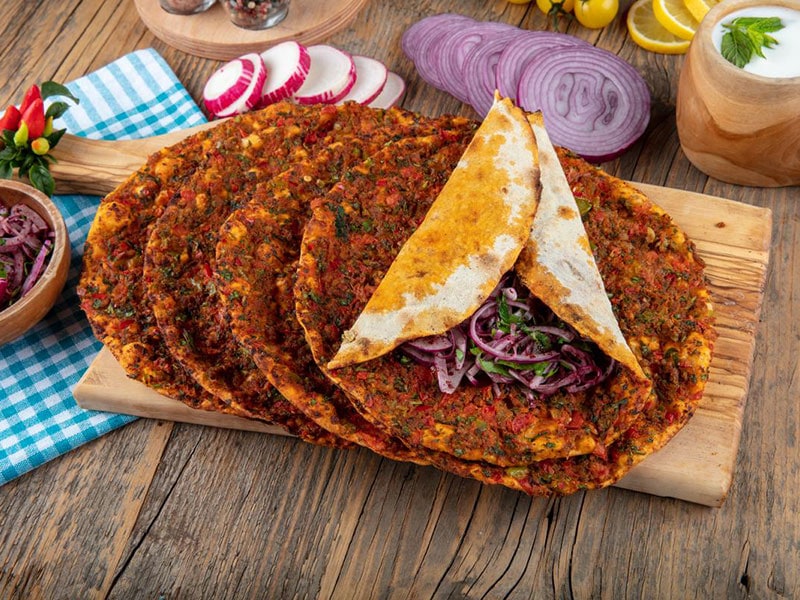
Lahmacun, also known as Armenian pizza, is a mouthwatering dish popular in the Levant, Turkey, and Armenia. When served, Lahmacun is often wrapped around a variety of vegetables, including tomatoes, pickles, roasted eggplant, and more.
This thin and crispy flatbread is characterized by a flavorful mixture of minced meat, typically lamb or beef, along with minced vegetables and aromatic herbs such as garlic, onions, red peppers, parsley, and tomatoes.
Spiced with paprika and chili pepper, Lahmacun offers a kick of heat. Most often, it’s baked in a high-temperature, wood-fired oven for the dough to turn golden and crispy while the toppings infuse it with savory goodness.
50. Pita (Flatbread) – Middle East
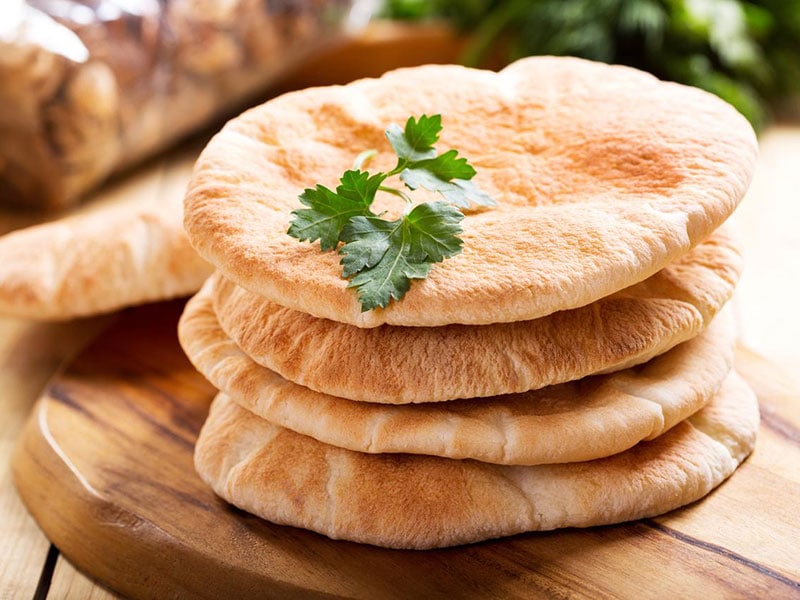
Known as Lebanese, Syrian, or Arabic bread, this wheat flour-based flatbread is among the oldest variety in the world. Its roots trace back to the Levant, the Mediterranean, and nearby areas. Typically, pita is crafted with yeast-leavened dough and proofed in less than 15 minutes.
High-temperature baking turns this humble dough into round flatbreads, with heat-induced pockets lending a distinct feature. These pockets of pita are fantastic for scooping up sauces or dips and wrapping delicious fillings like gyros, falafel, or kebabs.
In some instances, pita is baked intentionally without these pockets, hence the name “pocketless pita”. For a snack, slice and bake the pita into crispy chips to enjoy with whatever dip you have.
In Turkish cuisine, “pide” represents three bread styles relating to pita. Furthermore, Cypriot pita leans towards the rounder, fluffier side, while in Israel, the preferred Druze-style pita brims with labneh yogurt and is adorned with za’atar and olive oil.
51. Pilaf – Middle East
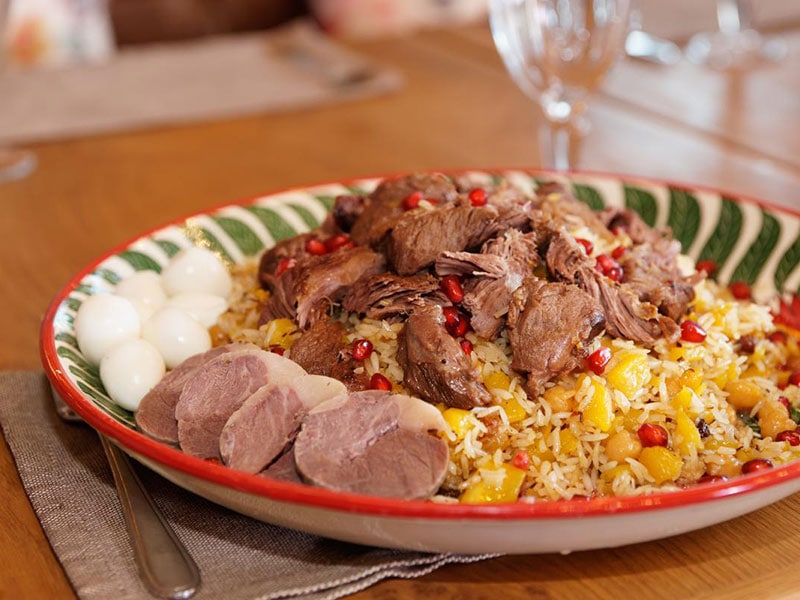
Pilaf, a beloved staple in the Middle East, shines as both a main dish and a side dish across many countries in the region. This versatile dish can be made with rice or, in some regions, with wheat, offering a variety of flavors and textures.
Commonly, basmati rice, known for its fluffy and separated grains, is often the preferred choice, although other long-grain rice varieties can be used. The essence of pilaf lies in cooking the rice with stock or broth, spices, meat, and vegetables, resulting in a tasty profile.
The rice dish often goes by different names like Polao, Pilov, Plao, Plov, and more, with thousands of variations, from various meats and vegetables to even fruits. While some pilaf recipes are simple, served plain to focus on the flavors of the grains, others feature complex ingredients.
Additionally, Afghan cuisine presents the flavorful Kabuli palaw with basmati rice and a choice of lamb, beef, chicken, or mutton. Also, Armenian pilaf dishes often feature bulgur (“cracked wheat”), while Azerbaijani cuisine boasts over 40 pilaf recipes.
52. Kebab – Middle East
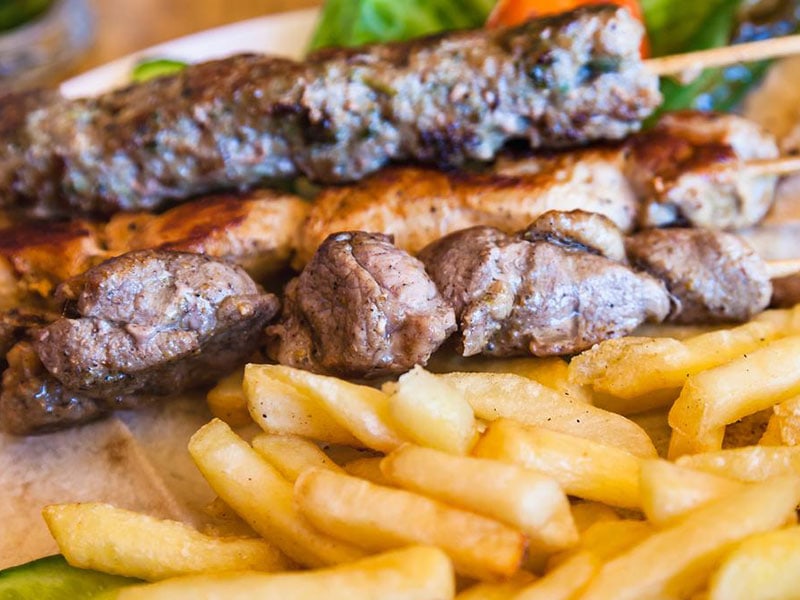
Consisting of cut-up or ground meat and sometimes vegetables, kebabs are usually cooked on a skewer over a fire for a savory aroma. I’ve even tasted some prepared as a stew, such as the famous Tas Kebab.
Also, you may find popular variants like the doner kebab with bread or the lovely skewered shish kebab. In Iran, the kebab usually pairs with Persian rice or steamed, saffron-flavored basmati in a delightful dish known as chelow kabab.
On the other hand, in the Levant and Egypt, shish taouk is a variety boasting marinated and grilled chicken skewers. However, I must admit, my all-time favorite has to be the Turkish Adana kebap, a long, hand-minced meat kebab grilled over charcoal on a wide iron skewer.
53. Quzi/Shuwaa/Qoozi/Ghoozi (Lamb Over Rice) – Middle East
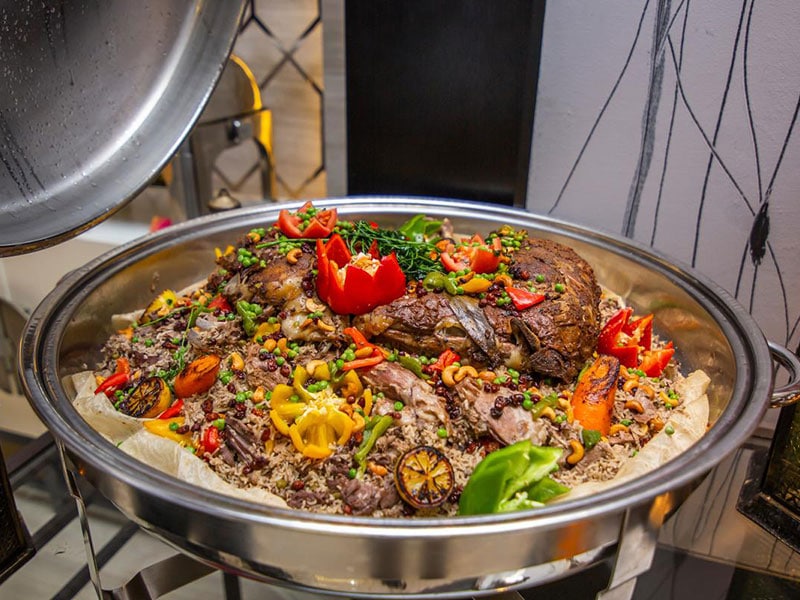
Quzi is a rice-based dish with a special place in the list of Iraq’s national dishes. The dish features tender, slow-cooked lamb served over fragrant rice, accompanied by raisins and roasted nuts.
In Iraqi cuisine, the dish is traditionally prepared by stuffing a whole lamb with a flavorful mixture of rice, spices, vegetables, and nuts. The lamb is then slow-cooked, often in a submerged or closed oven, allowing the flavors to meld together perfectly.
In other parts of the Middle East, the cooking method may involve burying the lamb in a pit with burning coal or charcoal. In Saudi Arabia and Yemen, it is known as Madfoon, while in the UAE and Oman, it goes by the name Shuwaa.
54. Hummus (Arabic Chickpea Dip) – Middle East
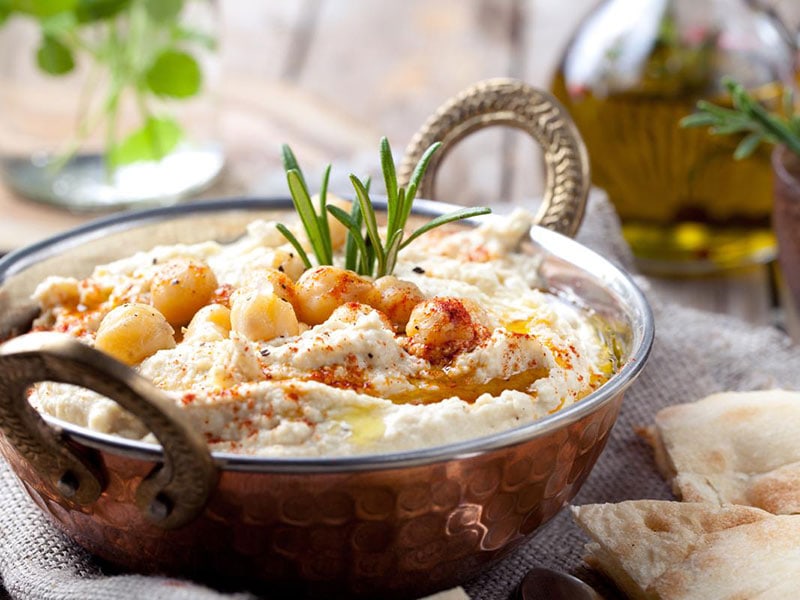
Hummus, a spread of Arab origin, has its birthplace and the exact date of its invention shrouded in mystery. However, the earliest written recipes resembling hummus bi tahina can be traced back to a 13th-century cookbook.
This lovely dip is crafted from cooked, mashed chickpeas, blending seamlessly with tahini, olive oil, and lemon juice. The result is a creamy paste that captivates with its rich umami flavor. Usually, Hummus is a fusion of nutty, savory, and earthy notes that ideally pairs with pita bread.
In today’s world, hummus production is a booming industry, serving as an appetizer or snack, accompanying crunchy crackers.
Beyond its delicious taste, hummus has notable health benefits too. Chickpeas, its primary ingredient, can help control blood sugar, aid digestion, prevent cancer, and even lower cholesterol levels [3].
55. Falafel (Chickpea Fritter) – Middle East
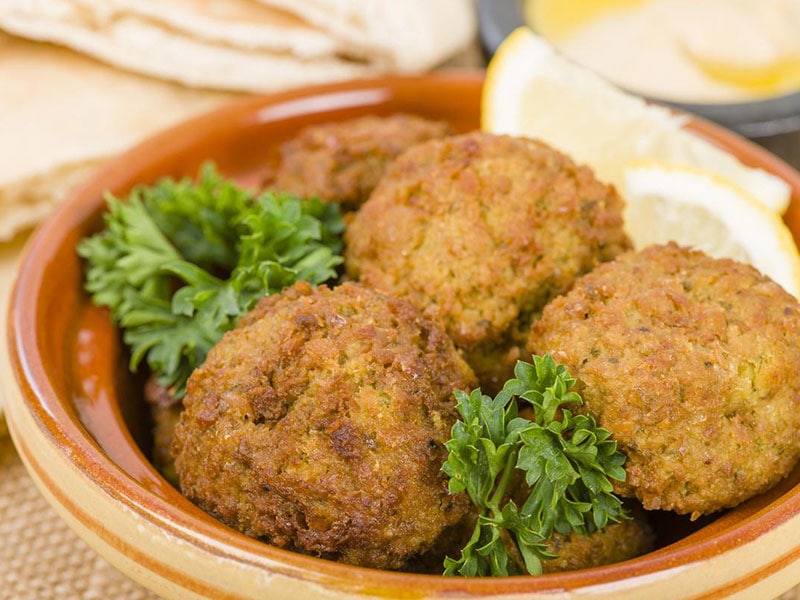
Falafel, a ball or patty-shaped fritter, finds its roots in Arab origin, gracing the Middle Eastern cuisine with its distinct presence. These deep-fried delights are crafted from ground chickpeas or a mixture of them and ground fava beans.
Street food stands throughout the Middle East flaunt this delicacy, and it’s also a standout star in Israeli cuisine, even becoming the Israeli national dish. Tucked into a warm pita or samoon, or swaddled in a flatbread known as taboon, falafel has a way of stealing the show.
Crowned with a colorful mix of pickles, salads, and tahini-based sauce (or hot sauce), falafel contains layers of flavors. Falafel often pairs great in a whole sandwich, filled with these crispy, golden fritters. It’s become a trusted staple in many vegetarian and vegan diets for its rich protein content.
56. Kibbeh (Stuffed Croquettes) – Middle East
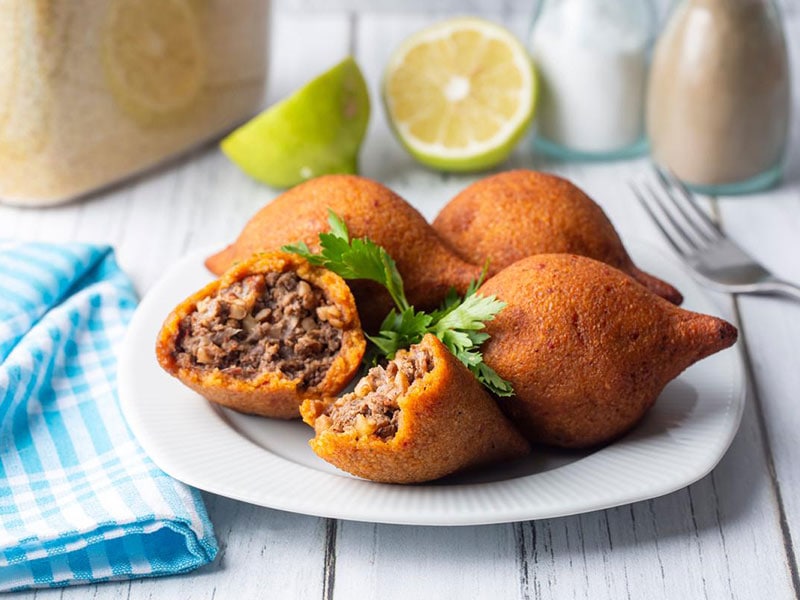
Kibbeh, a constellation of dishes known for spiced ground meat, grain, and onions, holds its own in the culinary world. Renowned as a national dish of Lebanon and Syria, it has managed to become a beloved staple across the Levant.
The secret to kibbeh lies in Levantine cuisine, where bulgur wheat and meat are pounded into a fine paste. This mixture is then formed into balls, coated with toasted pine nuts and aromatic spices.
Then, you can find it layered and deep-fried or perhaps grilled. Some folks prefer the dish cooked on a tray, while some enjoy it raw. Also, the delicacy has many versions savored in Israel, Cyprus, Palestine, Iraq, Turkey, Armenia, and more.
57. Knafeh (Middle Eastern Sweet Cheese Pastry) – Middle East
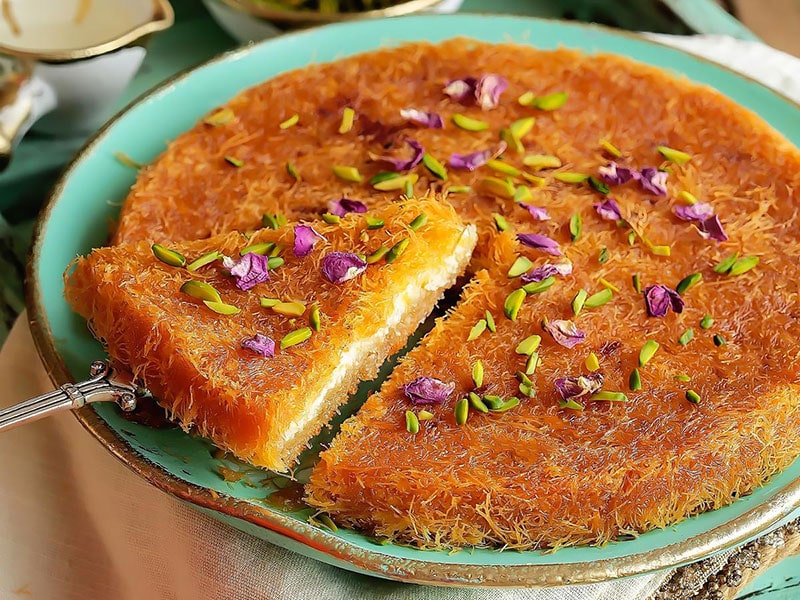
Knafeh, a lip-smacking dessert, has a connection with the Arab Fatimid culture. Legend has it; this dessert was a prescription by doctors to satiate the hunger of caliphs during Ramadan.
Its soul lies in kataifi, a spun pastry, referring to the thread-like dough or the whole dish. With a soak in attar, a sweet syrup, the mixture infuses this delicacy with unforgettable flavor. Also, Knafeh boasts layers of cheese, pistachio, clotted cream, or nuts.
Interestingly, the flavor twists come from orange juice or rose water. The resulting dessert is a sublime fusion of buttery crunchiness. One iconic variant is Knafeh Nabulsiye, which spotlights Nabulsi, a distinguished white-brine cheese.
58. Shakshuka (Poached Eggs In Spicy Tomato Sauce) – Middle East
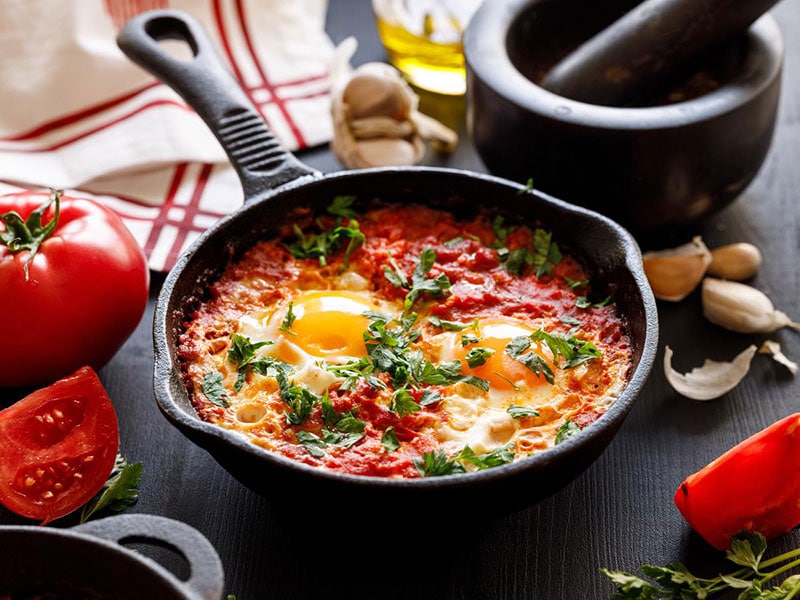
According to Joan Nathan, its history traces back to Ottoman North Africa in the mid-16th century, linked to the introduction of tomatoes to the region post the Columbian exchange. Yet, the dish stirs up a simmering controversy, with several countries claiming its origin.
Shakshuka is a Maghrebi dish with eggs gently poached in a vivid tomato sauce blended with peppers, olive oil, onion, and garlic. Hints of paprika, cumin, and cayenne pepper add a spice note, with every vegetable fried to perfection.
Most often, you will find a dollop of yogurt accompanying Shakshuka to add a cool counterpoint to the heat. The sauce base is versatile, transforming with sweetness or spice intensity variations. Commonly, people often enjoy Shakshuka in the golden hours of breakfast or brunch.
59. Dolma (Stuffed Grape Leaves)- Middle East
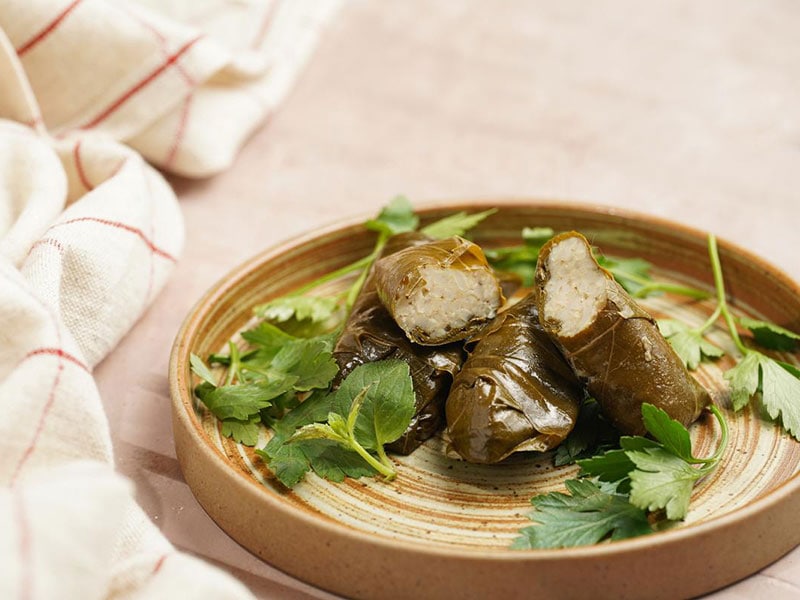
Dolma, also known as sarma, is a beloved dish in the Middle East and prevalent in the cuisines of countries once part of the Ottoman Empire. The word “dolma,” derived from Turkish, means “something stuffed” or “filled.”
This dish consists of a variety of fillings, such as minced meat, rice, fruit, offal, seafood, or a combination of ingredients that is encased within a vegetable or leaf wrapping.
Grape leaves and vine leaves are popular choices for wrapping, along with cabbage, eggplant, onion, and artichoke hearts. The dolmas can be served warm or at room temperature, allowing the flavors to meld together.
60. Maamoul (Date Filled Cookies) – Middle East
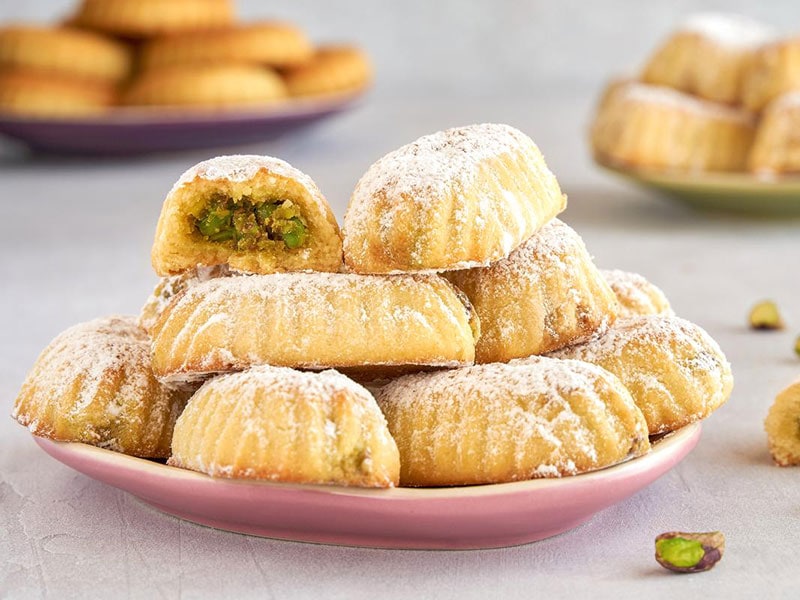
Maamoul, a Middle Eastern delicacy, has gained popularity throughout the Arab world, particularly in the Arabian peninsula. These delectable treats are filled butter cookies made with semolina flour, offering a good texture and flavor.
The filling of Maamoul can vary, commonly featuring dried fruits such as dates or figs and nuts like walnuts, almonds, or pistachios. The cookies come in various shapes, including balls, domed or flattened cookies, and can be hand-decorated or made using special wooden molds called tabe.
Maamoul is often made during festive occasions such as Purim, Easter, and days leading up to Eid celebrations. However, they are also enjoyed throughout the year, serving as delightful treats for special gatherings or everyday indulgences.
61. Chorba Frik (Lamb, Tomato, and Frik Soup) – Middle East
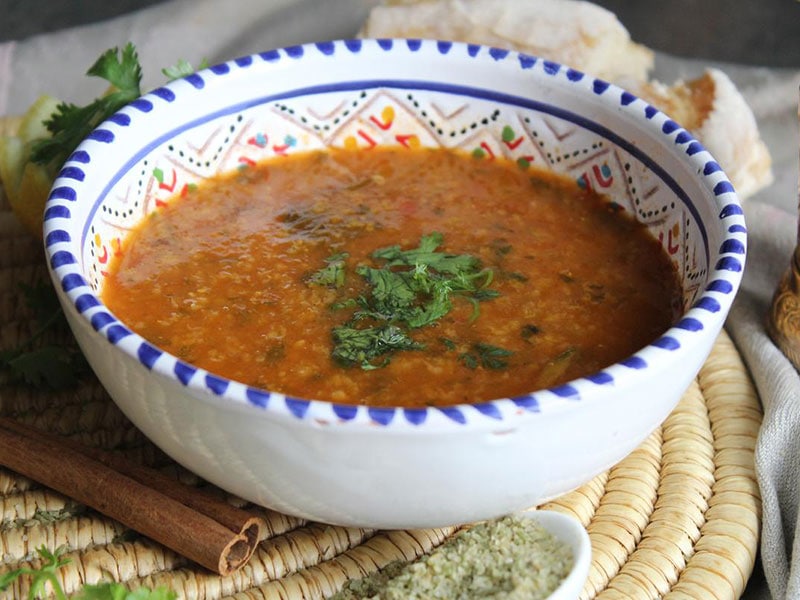
Chorba Frik, a hearty and nutritious soup, originates from Tunisia, Algeria, Libya, and the Middle East. This flavorsome dish combines tender lamb or beef, frik (roasted and husked green wheat), and various vegetables.
Commonly, the Frik undergoes a process of roasting and husking, resulting in a distinctive texture and flavor. Most often, various spices and herbs such as cumin, turmeric, mint, and coriander are added to enhance the soup’s taste.
Chorba Frik is particularly popular in winter, providing warmth and nourishment. It also holds a special place during Ramadan, which is enjoyed as part of the iftar meal. Served alongside bread, this soup becomes a complete and satisfying meal.
62. Couscous – Middle Eastern
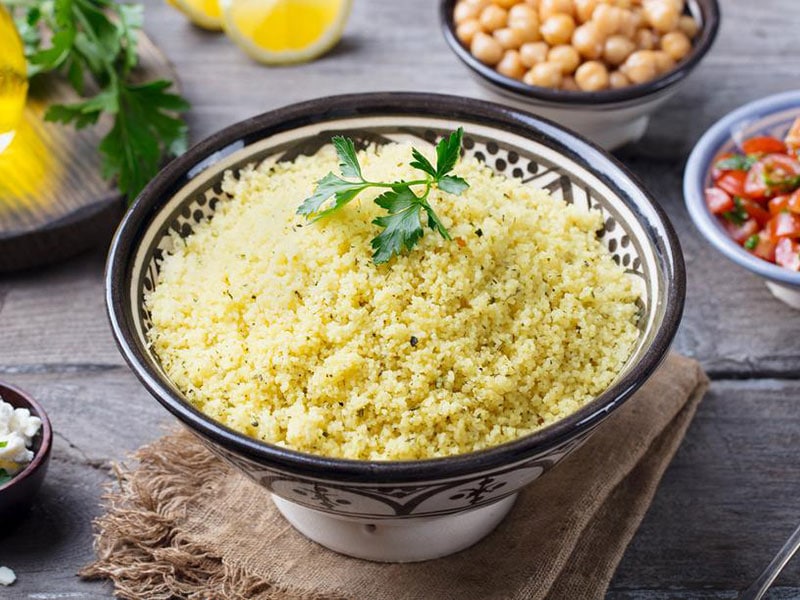
Couscous, a beloved dish in Middle Eastern cuisine, consists of small steamed granules made from rolled semolina. It is traditionally served with a flavorful stew spooned on top, allowing the couscous to soak up the delicious flavors.
While semolina is the most common grain used, variations of couscous can also be made with pearl millet, bulgur, sorghum, and other cereals. These variations, cooked similarly, are sometimes referred to as couscous.
Furthermore, Couscous is a staple food in the Maghrebi cuisines, offering a mild and neutral taste that complements a wide range of dishes. Although the exact origin of couscous remains unclear, its cultural significance was recognized in 2020 when it was added to UNESCO’s Intangible Cultural Heritage list [4].
63. Om Ali (Egyptian Bread Pudding) – Middle East
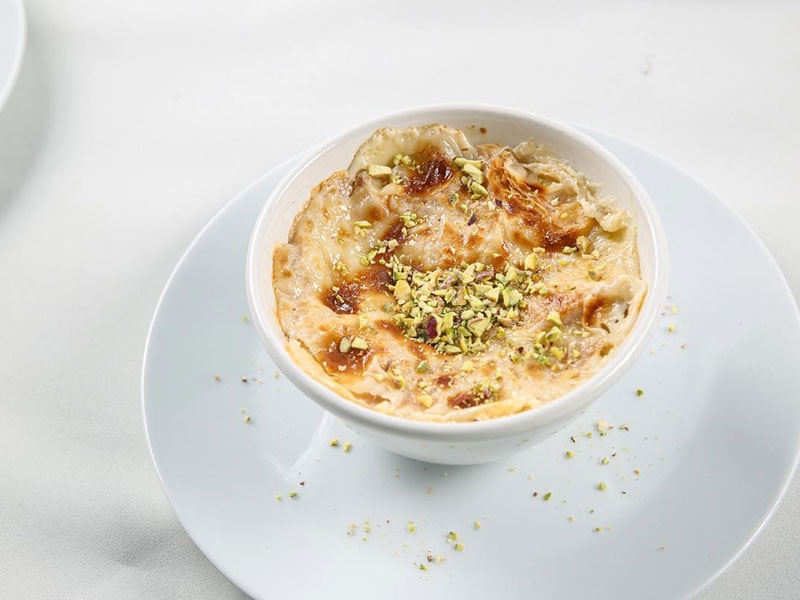
This beloved dessert can be traced back to Medieval Egypt and is said to be named after the wife of the Sultan of Egypt. In celebrating culinary excellence, she invited cooks and women from all corners of Egypt to compete and create the most delicious dessert.
The winning recipe, known as Om Ali, was later shared throughout the country, spreading its fame far and wide. During the holy month of Ramadan, Om Ali takes its place as a cherished part of the iftar, the meal that breaks the fast at sunset, whether enjoyed hot or cold.
This traditional Egyptian dessert and national delicacy of Egypt is a true Middle Eastern dish. To make Om Ali, a pastry like bread, pastry, or puff pastry is broken into pieces and combined with luscious ingredients such as coconut flakes, pistachios, raisins, and a generous amount of sugar.
The mixture is then drenched in milk, sometimes enriched with cream, creating a creamy and decadent base. In addition, a sprinkle of cinnamon adds a delicious touch of warmth. Then comes the baking process until you get a glorious golden brown on Om Ali’s surface.
64. Kofta (Meatballs) – Middle East
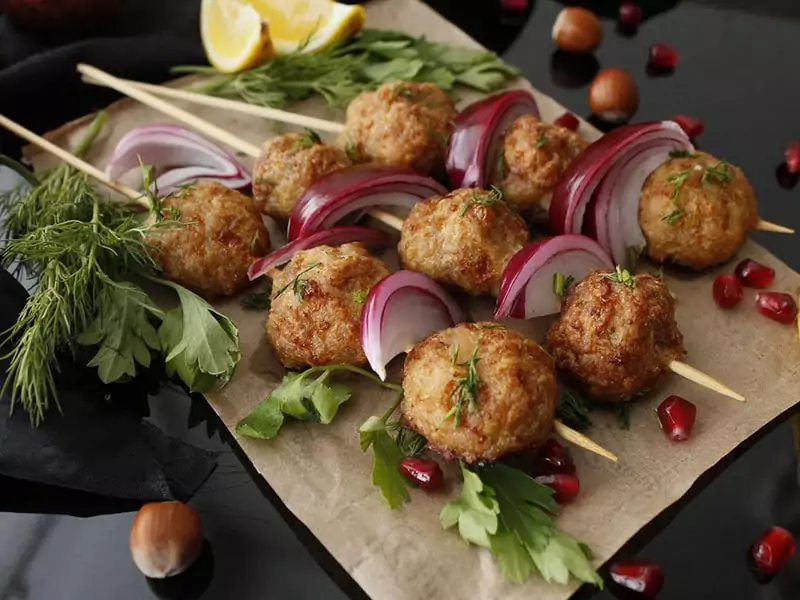
Kofta, a family of meatball dishes, can be found across a wide range of cuisines in the Middle East, the Balkans, the South Caucasus, North Africa, South Asia, and Central Asia. Its roots trace back to early Arab cookbooks, where the earliest known recipes were documented.
These meatballs combine minced meat, such as pork, chicken, mutton, or lamb, with a bold blend of rich spices. The result is a burst of flavor that varies from region to region. Also, Kofta comes in various forms, including balls, patties, and cylinders, ranging from golf balls to orange size.
Additionally, vegetable-based and uncooked Kofta are available for those with different dietary preferences. Locals often serve Kofta as an appetizer, a satisfying lunch, or a hearty dinner alongside fragrant rice, warm pita bread, and a selection of fresh vegetables.
65. Asida (Flour Pudding) – Middle East
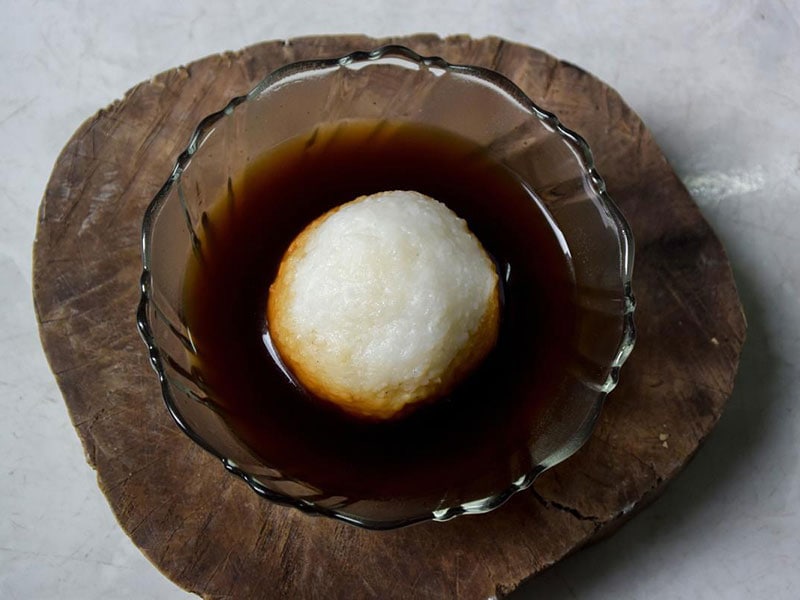
Asida, a traditional dish that holds a special place in the hearts of many Arab countries, is a popular dessert in the Middle East. It’s a simple yet rich treat that combines wheat flour with boiling water to create a lump of dough.
Sometimes, a touch of butter or honey is added, giving it an extra flavor. Similar in texture to fufu, Asida is a versatile dish that can be enjoyed independently without any accompaniment.
Traditionally served at breakfast, Asida is also lovingly prepared for women in labor, providing them with nourishment and energy. Moreover, you’ll often find Asida gracing the tables during religious holidays like Eid and Mawlid and other traditional ceremonies.
FAQs
Closing Remarks On Middle Eastern Gastronomy
Middle Eastern foods weave a tapestry of flavors that is as diverse and colorful as the region itself. Every dish tells a story worth savoring, from crunchy falafel to succulent kibbeh, dreamy Knafeh, and inviting shakshuka.
I hope you’ve savored this culinary exploration as much as I enjoyed guiding you through it. Don’t forget to like, share, and drop a comment to keep the conversation going. Let’s celebrate the taste of the Middle East together!
References
- ‘lavash bread’ on UNESCO Intangible Cultural Heritage List (2014) Financial Tribune.
- Berger, M. (2022) The deadly dish people love to eat, BBC Travel.
- Health benefits of chickpeas (no date) WebMD.
- UNESCO’s inscription of couscous traditions, an example of international cultural cooperation (no date) UNESCO.org.

